Featured Profiles
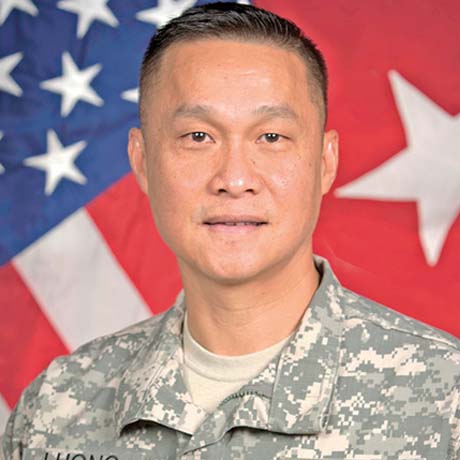
Major General
Viet Xuan Luong
2014: The first Vietnamese-born general officer in the U.S. military
READ MOREViet Xuan Luong
 2014: The first Vietnamese-born general officer in the U.S. military
2014: The first Vietnamese-born general officer in the U.S. military
Luong emigrated from Vietnam with his family to the United States in 1975 as a political refugee. Luong came to the United States as part of Operation Frequent Wind, a mission to help rescue Vietnamese citizens from the country during the final days of the Vietnam War. Luong's nearly 27-year military career stemmed from his experience on the deck of the USS Hancock when he was a little boy leaving Vietnam.
Almost 40 years after his rescue, family and friends watched as Luong became the first Vietnamese-born general officer in the U.S. military during a promotion ceremony on Cooper Field at Fort Hood, Texas, where he was promoted to the rank of brigadier general, Aug. 8, 2014.
Luong retired in 2021 after 34 years of dedicated and faithful service in the U.S. Army.
Related Articles
Vietnamese-born 'First Team' officer makes history
First US general of Vietnamese descent recalls harrowing escape from war
Major General Viet Xuan Luong
2014: The first Vietnamese-born general officer in the U.S. military
Luong emigrated from Vietnam with his family to the United States in 1975 as a political refugee. Luong came to the United States as part of Operation Frequent Wind, a mission to help rescue Vietnamese citizens from the country during the final days of the Vietnam War. Luong's nearly 27-year military career stemmed from his experience on the deck of the USS Hancock when he was a little boy leaving Vietnam.
Almost 40 years after his rescue, family and friends watched as Luong became the first Vietnamese-born general officer in the U.S. military during a promotion ceremony on Cooper Field at Fort Hood, Texas, where he was promoted to the rank of brigadier general, Aug. 8, 2014.
Luong retired in 2021 after 34 years of dedicated and faithful service in the U.S. Army.
Related Articles
Vietnamese-born 'First Team' officer makes history
First US general of Vietnamese descent recalls harrowing escape from war
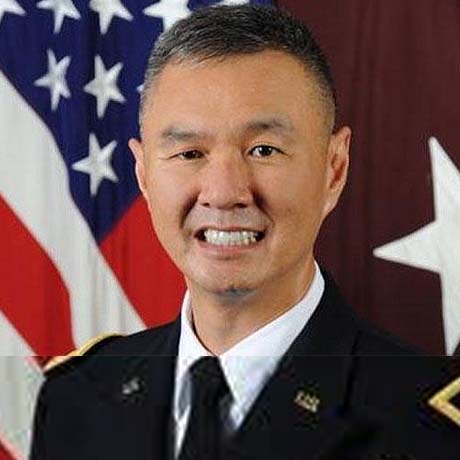
Brigadier General
John M. Cho
2013: The first Korean American to reach the rank of brigadier general in the Army active component
READ MOREJohn M. Cho
 2013: The first Korean American to reach the rank of brigadier general in the Army active component
2013: The first Korean American to reach the rank of brigadier general in the Army active component
John M. Cho achieved the rank of brigadier general, June 21, 2013, at Fort Meyer, Virginia.
Cho is a graduate of the United States Military Academy, West Point, N.Y., and the Uniformed Services University of Health Sciences, Bethesda, Maryland. He completed residencies in general surgery at Fitzsimons Army Medical Center, Aurora, Colorado, and Cardiothoracic Surgery at Walter Reed Army Medical Center, Washington, D.C. Cho also completed subspecialty fellowship training in Pediatric and complex Adult Cardiothoracic Surgery at the Mayo Clinic, Rochester, Minn. He is a 2008 graduate of the U.S. Army War College where he received a master's in Strategic Studies.
Cho is board certified as a diplomat of the American Board of Surgery and the American Board of Thoracic Surgery. He is a fellow of the American College of Surgeons. He holds active membership in the Society of Thoracic Surgery, and is a certified physician executive of the American College of Physician Executives. Cho's 30 publications, grants and abstracts include two of the world's largest series in cardiac surgery and from 2006 to 2010, he was the consultant to the Army Surgeon General in Cardiothoracic Surgery. Cho retired from Army service in 2017.
Related Articles
First active component American of Korean descent promoted to brigadier general
Brigadier General John M. Cho
2013: The first Korean American to reach the rank of brigadier general in the Army active component
John M. Cho achieved the rank of brigadier general, June 21, 2013, at Fort Meyer, Virginia.
Cho is a graduate of the United States Military Academy, West Point, N.Y., and the Uniformed Services University of Health Sciences, Bethesda, Maryland. He completed residencies in general surgery at Fitzsimons Army Medical Center, Aurora, Colorado, and Cardiothoracic Surgery at Walter Reed Army Medical Center, Washington, D.C. Cho also completed subspecialty fellowship training in Pediatric and complex Adult Cardiothoracic Surgery at the Mayo Clinic, Rochester, Minn. He is a 2008 graduate of the U.S. Army War College where he received a master's in Strategic Studies.
Cho is board certified as a diplomat of the American Board of Surgery and the American Board of Thoracic Surgery. He is a fellow of the American College of Surgeons. He holds active membership in the Society of Thoracic Surgery, and is a certified physician executive of the American College of Physician Executives. Cho's 30 publications, grants and abstracts include two of the world's largest series in cardiac surgery and from 2006 to 2010, he was the consultant to the Army Surgeon General in Cardiothoracic Surgery. Cho retired from Army service in 2017.
Related Articles
First active component American of Korean descent promoted to brigadier general
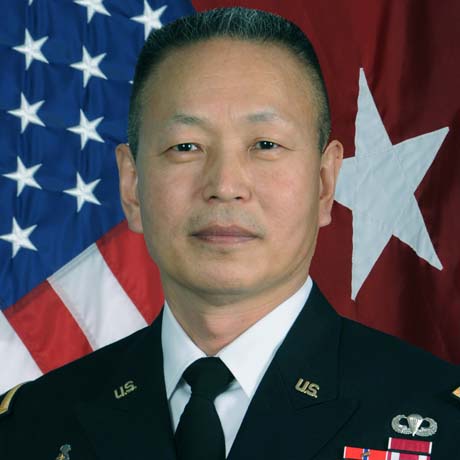
Brigadier General
Stephen K. Curda
2012: The first Korean American to reach the rank of brigadier general in the Army Reserve component
READ MOREStephen K. Curda
 2012: The first Korean American to reach the rank of brigadier general in the Army Reserve component
2012: The first Korean American to reach the rank of brigadier general in the Army Reserve component
Stephen K. Curda was promoted to a brigadier general, Aug. 5, 2012, at Mountain View, California. The Pentagon announced, July 2, 2015, that Curda was selected to lead all Army Reserve Soldiers in the Pacific. Curda retired from Army service in 2017.
Curda holds a doctorate in educational psychology and instructional technology, has held faculty and administrative positions at Florida State University, University of Toledo and University of West Florida. Currently, he is an associate professor at the National College of Education and special assistant to the president for veterans education at National Louis University.
Related Articles
Pacific-aligned Civil Affairs Command welcomes new commander
Civil Affairs Command completes change of command, ready for more Pacific operations
Pacific Army Reserve Soldiers Welcome New CDR; 9th MSC says Mahalo Curda, Aloha Anderson
Brigadier General Stephen K. Curda
2012: The first Korean American to reach the rank of brigadier general in the Army Reserve component
Stephen K. Curda was promoted to a brigadier general, Aug. 5, 2012, at Mountain View, California. The Pentagon announced, July 2, 2015, that Curda was selected to lead all Army Reserve Soldiers in the Pacific. Curda retired from Army service in 2017.
Curda holds a doctorate in educational psychology and instructional technology, has held faculty and administrative positions at Florida State University, University of Toledo and University of West Florida. Currently, he is an associate professor at the National College of Education and special assistant to the president for veterans education at National Louis University.
Related Articles
Pacific-aligned Civil Affairs Command welcomes new commander
Civil Affairs Command completes change of command, ready for more Pacific operations
Pacific Army Reserve Soldiers Welcome New CDR; 9th MSC says Mahalo Curda, Aloha Anderson
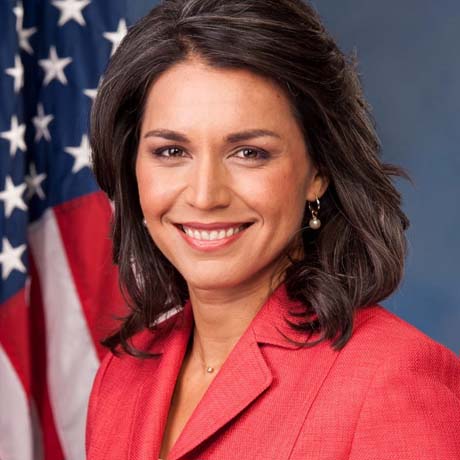
Representative
Tulsi Gabbard
2010: The first female American Samoan and Hindu elected to Congress
READ MORETulsi Gabbard
 2010: The first female American Samoan and Hindu elected to Congress
2010: The first female American Samoan and Hindu elected to Congress
Tulsi Gabbard is the first American Samoan, the first Hindu member and one of the first female combat veterans to serve in the U.S. Congress. Gabbard was the first female Distinguished Honor Graduate at Fort McClellan's Officer Candidate School, and was the first woman to ever receive an award of appreciation from the Kuwaiti military on her second overseas tour.
Gabbard was born in Leloaloa, American Samoa, in 1981. The fourth of five children, at the age of two, Gabbard and her family settled in Hawaii. As a teenager, she co-founded the Healthy Hawai'i Coalition, a non-profit, educational organization, made up of concerned citizens from across the state, whose two-fold purpose is to protect the environment and to improve individual and community health. An advocate for environmental policy, Gabbard ran for the Hawaii State Legislature in 2002 and became the youngest person ever elected. A year later, Gabbard joined the Hawaii National Guard to serve Hawaii's citizens and our country.
In 2004, Gabbard voluntarily deployed to Iraq with her fellow Soldiers of the 29th Brigade, eventually serving two tours of combat duty in the Middle East. Gabbard continues to serve the Hawaii National Guard's 29th Brigade Combat Team. In between her two tours, Gabbard worked in the U.S. Senate as a legislative aide to Sen. Daniel Akaka, where she advised the senator on energy independence, homeland security, the environment, and veterans' affairs.
In 2010, Gabbard ran for the Honolulu City Council and served as Chair of the Safety, Economic Development and Government Affairs committee and Vice Chair of the Budget committee. Gabbard represented Hawaii's 2nd congressional district from 2013 to 2021.
Related Articles
Tulsi Gabbard shares her experience for Army Women’s Mentorship Program
Representative Tulsi Gabbard
2010: The first female American Samoan and Hindu elected to Congress
Tulsi Gabbard is the first American Samoan, the first Hindu member and one of the first female combat veterans to serve in the U.S. Congress. Gabbard was the first female Distinguished Honor Graduate at Fort McClellan's Officer Candidate School, and was the first woman to ever receive an award of appreciation from the Kuwaiti military on her second overseas tour.
Gabbard was born in Leloaloa, American Samoa, in 1981. The fourth of five children, at the age of two, Gabbard and her family settled in Hawaii. As a teenager, she co-founded the Healthy Hawai'i Coalition, a non-profit, educational organization, made up of concerned citizens from across the state, whose two-fold purpose is to protect the environment and to improve individual and community health. An advocate for environmental policy, Gabbard ran for the Hawaii State Legislature in 2002 and became the youngest person ever elected. A year later, Gabbard joined the Hawaii National Guard to serve Hawaii's citizens and our country.
In 2004, Gabbard voluntarily deployed to Iraq with her fellow Soldiers of the 29th Brigade, eventually serving two tours of combat duty in the Middle East. Gabbard continues to serve the Hawaii National Guard's 29th Brigade Combat Team. In between her two tours, Gabbard worked in the U.S. Senate as a legislative aide to Sen. Daniel Akaka, where she advised the senator on energy independence, homeland security, the environment, and veterans' affairs.
In 2010, Gabbard ran for the Honolulu City Council and served as Chair of the Safety, Economic Development and Government Affairs committee and Vice Chair of the Budget committee. Gabbard represented Hawaii's 2nd congressional district from 2013 to 2021.
Related Articles
Tulsi Gabbard shares her experience for Army Women’s Mentorship Program
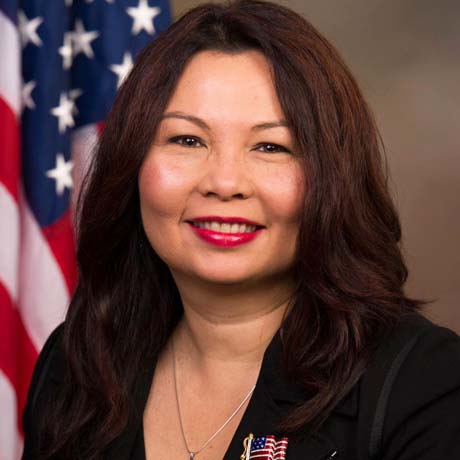
Senator
Tammy Duckworth
2006: The first Thai American elected to Congress
READ MORETammy Duckworth
 2006: The first Thai American elected to Congress
2006: The first Thai American elected to Congress
Tammy Duckworth is one of the first two female combat veterans, the first disabled woman to be elected to the U.S. Congress and the first member of Congress born in Thailand.
In 2004, then-Maj. Duckworth was deployed to Iraq as a Blackhawk helicopter pilot for the Illinois Army National Guard. She was one of the first Army women to fly combat missions during Operation Iraqi Freedom until her helicopter was hit by a rocket-propelled grenade, Nov. 12, 2004. Duckworth lost her legs and partial use of her right arm in the explosion and was awarded a Purple Heart for her combat injuries. She was the first female double amputee from the war. Duckworth spent the next year recovering at Walter Reed Army Medical Center. As one of the highest-ranking patients, she quickly became an advocate for her fellow Soldiers and testified before Congress about caring for our veterans and wounded warriors.
Following her recovery, Duckworth ran for Congress in 2006 and after a narrow loss, she became director of the Illinois Department of Veterans Affairs. In Illinois, she worked to create a tax credit for employers who hired Veterans, established a first-in-the-nation, 24/7 crisis hotline for Veterans and developed innovative programs to improve veterans' access to housing and health care.
In 2009, President Obama appointed Duckworth to be assistant secretary of veterans affairs. There, Duckworth led an initiative to end homelessness among veterans. She created the Office of Online Communications to improve the VA's accessibility, especially among young Veterans and also worked to address the unique challenges that American Indians and female Veterans face.
Duckworth ran to represent Illinois 8th congressional district in 2012 to advocate for the practical solutions and cooperation needed to rebuild our economy and ensure that every American has a chance to achieve the American Dream. Duckworth was then elected to the U.S. Senate, representing Illinois, in 2016.
Related Articles
Amputee shares story, encourages community
Duckworth, Vaught inducted into Army Women's Foundation hall of fame
VA official visits fellow Wounded Warriors with Georgia Senator
Senator Duckworth shares personal story during AAPI event
Video: Women's History Month - Lt. Col. Tammy Duckworth
Senator Tammy Duckworth
2006: The first Thai American elected to Congress
Tammy Duckworth is one of the first two female combat veterans, the first disabled woman to be elected to the U.S. Congress and the first member of Congress born in Thailand.
In 2004, then-Maj. Duckworth was deployed to Iraq as a Blackhawk helicopter pilot for the Illinois Army National Guard. She was one of the first Army women to fly combat missions during Operation Iraqi Freedom until her helicopter was hit by a rocket-propelled grenade, Nov. 12, 2004. Duckworth lost her legs and partial use of her right arm in the explosion and was awarded a Purple Heart for her combat injuries. She was the first female double amputee from the war. Duckworth spent the next year recovering at Walter Reed Army Medical Center. As one of the highest-ranking patients, she quickly became an advocate for her fellow Soldiers and testified before Congress about caring for our veterans and wounded warriors.
Following her recovery, Duckworth ran for Congress in 2006 and after a narrow loss, she became director of the Illinois Department of Veterans Affairs. In Illinois, she worked to create a tax credit for employers who hired Veterans, established a first-in-the-nation, 24/7 crisis hotline for Veterans and developed innovative programs to improve veterans' access to housing and health care.
In 2009, President Obama appointed Duckworth to be assistant secretary of veterans affairs. There, Duckworth led an initiative to end homelessness among veterans. She created the Office of Online Communications to improve the VA's accessibility, especially among young Veterans and also worked to address the unique challenges that American Indians and female Veterans face.
Duckworth ran to represent Illinois 8th congressional district in 2012 to advocate for the practical solutions and cooperation needed to rebuild our economy and ensure that every American has a chance to achieve the American Dream. Duckworth was then elected to the U.S. Senate, representing Illinois, in 2016.
Related Articles
Amputee shares story, encourages community
Duckworth, Vaught inducted into Army Women's Foundation hall of fame
VA official visits fellow Wounded Warriors with Georgia Senator
Senator Duckworth shares personal story during AAPI event
Video: Women's History Month - Lt. Col. Tammy Duckworth
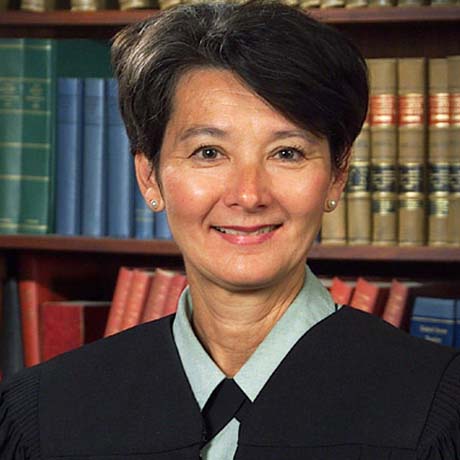
Brigadier General, Judge
Coral W. Pietsch
2001: The first female Asian American general officer in the U.S. Army
READ MORECoral W. Pietsch
 2001: The first female Asian American general officer in the U.S. Army
2001: The first female Asian American general officer in the U.S. Army
Coral W. Pietsch became the first woman to be promoted to the rank of brigadier general in the U.S. Army Judge Advocate General's Corps in 2001. In her military career, Judge Pietsch participated in numerous exercises and deployments throughout the Asia Pacific Region. Pietsch retired from Army service in 2007.
As part of the 2007 "surge" in Iraq, Pietsch volunteered as a Department of Defense civilian to deploy to Iraq for a year where she was seconded to the U.S. Department of State to serve as the deputy rule of law coordinator for the Baghdad Provincial Reconstruction Team. During her deployment to Iraq, Pietsch assisted with numerous civil society projects involving a variety of Rule of Law partners, including the Iraqi Jurist Union, Iraqi Bar Association, law schools, and international rights, women's rights and human rights organizations. She evaluated and sought funding for numerous projects aimed at building capacity within the Iraqi legal community to include the establishment, in close collaboration with the Iraqi Bar Association, of a Legal Aid Clinic at one of the Iraq's largest detention facilities. During her time in Iraq, she also established meaningful relationships with numerous Government of Iraq ministries, nongovernmental organizations, and Coalition partners to help reinvigorate the rule of law in Iraq.
Pietsch was nominated by President Barack Obama and subsequently appointed a judge of the U.S. Court of Appeals for Veterans Claims in June 2012.
Related Articles
Waterloo to Washington: The Long Journey of Coral Wong Pietsch
Brigadier General, Judge Coral W. Pietsch
2001: The first female Asian American general officer in the U.S. Army
Coral W. Pietsch became the first woman to be promoted to the rank of brigadier general in the U.S. Army Judge Advocate General's Corps in 2001. In her military career, Judge Pietsch participated in numerous exercises and deployments throughout the Asia Pacific Region. Pietsch retired from Army service in 2007.
As part of the 2007 "surge" in Iraq, Pietsch volunteered as a Department of Defense civilian to deploy to Iraq for a year where she was seconded to the U.S. Department of State to serve as the deputy rule of law coordinator for the Baghdad Provincial Reconstruction Team. During her deployment to Iraq, Pietsch assisted with numerous civil society projects involving a variety of Rule of Law partners, including the Iraqi Jurist Union, Iraqi Bar Association, law schools, and international rights, women's rights and human rights organizations. She evaluated and sought funding for numerous projects aimed at building capacity within the Iraqi legal community to include the establishment, in close collaboration with the Iraqi Bar Association, of a Legal Aid Clinic at one of the Iraq's largest detention facilities. During her time in Iraq, she also established meaningful relationships with numerous Government of Iraq ministries, nongovernmental organizations, and Coalition partners to help reinvigorate the rule of law in Iraq.
Pietsch was nominated by President Barack Obama and subsequently appointed a judge of the U.S. Court of Appeals for Veterans Claims in June 2012.
Related Articles
Waterloo to Washington: The Long Journey of Coral Wong Pietsch
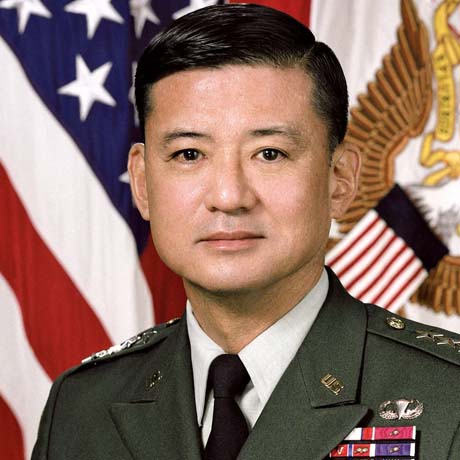
General, Chief of Staff of the Army
Eric K. Shinseki
1999: The first Asian American four-star general and 34th Chief of Staff of the Army
READ MOREEric K. Shinseki
 1999: The first Asian American four-star general and 34th Chief of Staff of the Army
1999: The first Asian American four-star general and 34th Chief of Staff of the Army
Erik K. Shinseki made history in 1997 as the first Asian American promoted to the rank of general. He was tasked with being commanding general of U.S. Army Europe, commander of Allied Land Forces Central Europe and commander of NATO's Stabilization Force in Bosnia-Herzegovina. Two years later, after a short assignment as the vice chief of staff, Shinseki became the 34th Chief of Staff of the Army. Shinseki credited his mother and the brave Asian Americans who served in World War II for paving the way for his success during a speech at the installation's Asian Pacific American Heritage Month Observance.
Shinseki assumed duties as the 28th Vice Chief of Staff, United States Army, Nov. 24, 1998. Shinseki assumed duties as the 34th Chief of Staff, United States Army, June 22, 1999. He retired from the United States Army in June 2003. Shinseki made history again as the first Asian American to hold the post of secretary of veterans affairs, serving from 2009 to 2014 in the Obama administration.
Related Articles
Shinseki sworn in as VA secretary
West Point honors 6 distinguished graduates
General, Chief of Staff of the Army Eric K. Shinseki
1999: The first Asian American four-star general and 34th Chief of Staff of the Army
Erik K. Shinseki made history in 1997 as the first Asian American promoted to the rank of general. He was tasked with being commanding general of U.S. Army Europe, commander of Allied Land Forces Central Europe and commander of NATO's Stabilization Force in Bosnia-Herzegovina. Two years later, after a short assignment as the vice chief of staff, Shinseki became the 34th Chief of Staff of the Army. Shinseki credited his mother and the brave Asian Americans who served in World War II for paving the way for his success during a speech at the installation's Asian Pacific American Heritage Month Observance.
Shinseki assumed duties as the 28th Vice Chief of Staff, United States Army, Nov. 24, 1998. Shinseki assumed duties as the 34th Chief of Staff, United States Army, June 22, 1999. He retired from the United States Army in June 2003. Shinseki made history again as the first Asian American to hold the post of secretary of veterans affairs, serving from 2009 to 2014 in the Obama administration.
Related Articles
Shinseki sworn in as VA secretary
West Point honors 6 distinguished graduates
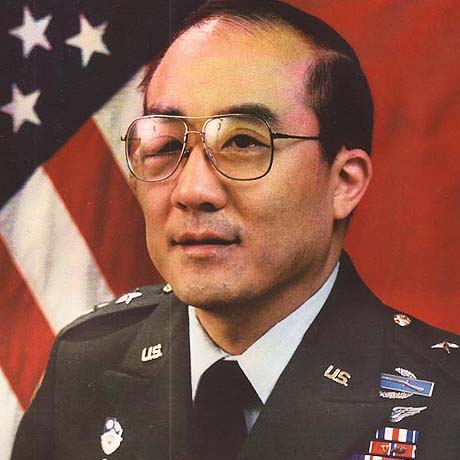
Major General
James Mukoyama
1989: The first Asian American to command an Army Division
READ MOREJames Mukoyama
 1989: The first Asian American to command an Army Division
1989: The first Asian American to command an Army Division
Major General James Mukoyama completed his master's in Teaching of Social Studies in just one year, while attending Officer Candidate School, and earning his Jump wings. He was sent to Korea and, following repeated requests, to Vietnam, where he commanded an infantry company before serving as an advisor to Army of the Republic of Vietnam units in the northern part of South Vietnam.
Shortly after his tour in Vietnam, Mukoyama left active duty and joined the reserves, serving with training divisions in Illinois, Michigan, and Indiana. In 1986, Mukoyama was promoted to brigadier general, becoming the youngest general in the Army at that time. In just three more years, he was promoted to major general, where he commanded the 70th Training Division.
After retiring from 32 years of military service in 1995, Mukoyama continued his deep involvement in the military through Veterans' advocacy programs, helping create the Military Outreach of Greater Chicago, serving as vice chair of the Secretary's Advisory Committee on Minority Veterans, and chairing a committee with the National Veterans' Network to select the design for the Congressional Gold Medal award authorized by the Congressional Gold Medal for Japanese American Veterans.
Major General James Mukoyama
1989: The first Asian American to command an Army Division
Major General James Mukoyama completed his master's in Teaching of Social Studies in just one year, while attending Officer Candidate School, and earning his Jump wings. He was sent to Korea and, following repeated requests, to Vietnam, where he commanded an infantry company before serving as an advisor to Army of the Republic of Vietnam units in the northern part of South Vietnam.
Shortly after his tour in Vietnam, Mukoyama left active duty and joined the reserves, serving with training divisions in Illinois, Michigan, and Indiana. In 1986, Mukoyama was promoted to brigadier general, becoming the youngest general in the Army at that time. In just three more years, he was promoted to major general, where he commanded the 70th Training Division.
After retiring from 32 years of military service in 1995, Mukoyama continued his deep involvement in the military through Veterans' advocacy programs, helping create the Military Outreach of Greater Chicago, serving as vice chair of the Secretary's Advisory Committee on Minority Veterans, and chairing a committee with the National Veterans' Network to select the design for the Congressional Gold Medal award authorized by the Congressional Gold Medal for Japanese American Veterans.
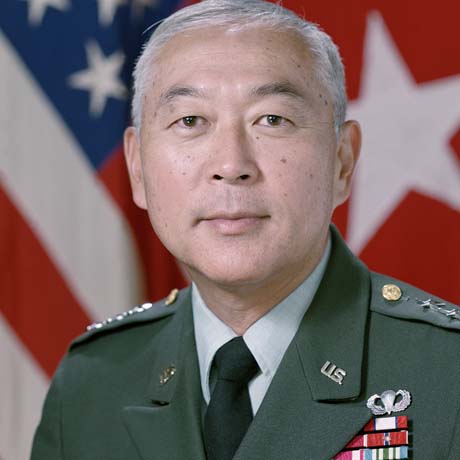
Lieutenant General
Allen K. Ono
1986: The Army's first Japanese American and Asian American lieutenant general
READ MOREAllen K. Ono
 1986: The Army's first Japanese American and Asian American lieutenant general
1986: The Army's first Japanese American and Asian American lieutenant general
Lieutenant General Allen K. Ono was born in Honolulu, Hawaii. He served in the Army for 35 years. He attended public schools in Hawaii and was commissioned to an infantry officer through the University of Hawaii's ROTC. His Army career included assignments at numerous mainland posts, Korea, Vietnam, Europe, and Panama, including Commander of the Army Recruiting Command. His final Army position was as the deputy chief of staff for personnel, 1986-1990, responsible for human resources policy for the entire Army.
Upon retirement from the Army, he returned to Hawaii as executive vice president and a member of the Board of Directors at American Savings Bank.
Lieutenant General Allen K. Ono
1986: The Army's first Japanese American and Asian American lieutenant general
Lieutenant General Allen K. Ono was born in Honolulu, Hawaii. He served in the Army for 35 years. He attended public schools in Hawaii and was commissioned to an infantry officer through the University of Hawaii's ROTC. His Army career included assignments at numerous mainland posts, Korea, Vietnam, Europe, and Panama, including Commander of the Army Recruiting Command. His final Army position was as the deputy chief of staff for personnel, 1986-1990, responsible for human resources policy for the entire Army.
Upon retirement from the Army, he returned to Hawaii as executive vice president and a member of the Board of Directors at American Savings Bank.
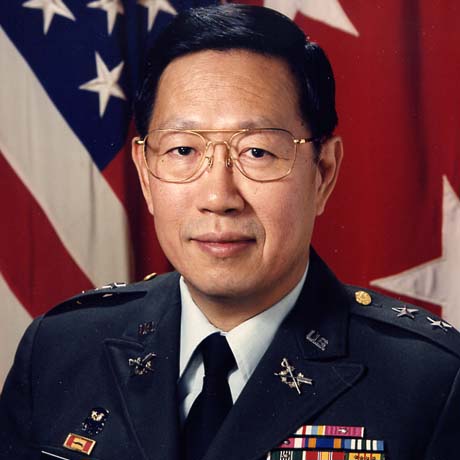
Major General
John Liu Fugh
1984: The first Chinese American general officer in the U.S. Army
READ MOREJohn Liu Fugh
 1984: The first Chinese American general officer in the U.S. Army
1984: The first Chinese American general officer in the U.S. Army
Major General John Liu Fugh was a Beijing native who left China with his family after the Communist takeover in 1949.
In 1984, Fugh was promoted to the rank of brigadier general, and became the assistant judge advocate general for civil law. In this position, he created the Army's first environmental law division and the procurement fraud division.
Upon his retirement in June 1993, Fugh became a partner in the law firm of McGuire, Woods, Battle and Boothe, Washington, D.C. From 1995 to 2000, he served as president for several U.S. companies in Beijing, including McDonnell Douglas that later merged with Boeing Company. As chief executive for these companies, he was responsible for strategic direction of business development and projects in China. His stature as a retired U.S. general officer, coupled with his ethnic background and fluency in Mandarin, facilitated in developing relationships with key Chinese government and industry decision-makers. Throughout his tour in Beijing, he served on the Board of the American Chamber of Commerce.
Fugh is currently Chairman of the Committee of 100, a national, non-partisan group of prominent Chinese Americans that brings bicultural perspectives to U.S. relations with China and addresses the concerns of Americans of Chinese/Asian descent. In addition, he serves on the Executive Committee and a director of the Atlantic Council of the United States, a public policy forum in Washington, D.C. He also serves on the Advisory Council of Asia Society, Washington Center, and a director of the National Japanese American Memorial Foundation.
Fugh graduated from the Georgetown University School of Foreign Service and the George Washington University Law School. He attended the Kennedy School of Government at Harvard University, the U.S. Army War College, and the U.S. Army Command & General Staff College. He is a member of the Bar of the District of Columbia.
Major General John Liu Fugh
1984: The first Chinese American general officer in the U.S. Army
Major General John Liu Fugh was a Beijing native who left China with his family after the Communist takeover in 1949.
In 1984, Fugh was promoted to the rank of brigadier general, and became the assistant judge advocate general for civil law. In this position, he created the Army's first environmental law division and the procurement fraud division.
Upon his retirement in June 1993, Fugh became a partner in the law firm of McGuire, Woods, Battle and Boothe, Washington, D.C. From 1995 to 2000, he served as president for several U.S. companies in Beijing, including McDonnell Douglas that later merged with Boeing Company. As chief executive for these companies, he was responsible for strategic direction of business development and projects in China. His stature as a retired U.S. general officer, coupled with his ethnic background and fluency in Mandarin, facilitated in developing relationships with key Chinese government and industry decision-makers. Throughout his tour in Beijing, he served on the Board of the American Chamber of Commerce.
Fugh is currently Chairman of the Committee of 100, a national, non-partisan group of prominent Chinese Americans that brings bicultural perspectives to U.S. relations with China and addresses the concerns of Americans of Chinese/Asian descent. In addition, he serves on the Executive Committee and a director of the Atlantic Council of the United States, a public policy forum in Washington, D.C. He also serves on the Advisory Council of Asia Society, Washington Center, and a director of the National Japanese American Memorial Foundation.
Fugh graduated from the Georgetown University School of Foreign Service and the George Washington University Law School. He attended the Kennedy School of Government at Harvard University, the U.S. Army War College, and the U.S. Army Command & General Staff College. He is a member of the Bar of the District of Columbia.
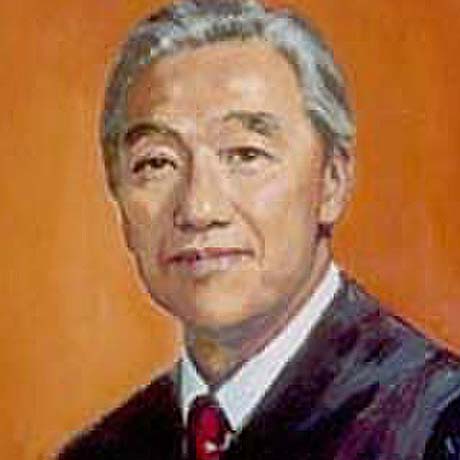
Lieutenant Colonel, Judge
Herbert Choy
1971: The first Asian American federal judge
READ MOREHerbert Choy
 1971: The first Asian American federal judge
1971: The first Asian American federal judge
Judge Herbert Choy was previously a first lieutenant in the Army and became the first Asian American federal judge in 1971 and the first person of Korean ancestry to be admitted to the bar in the United States. Fresh out of Harvard, Choy's life forever changed on the morning of Dec. 7, 1941, the attack on Pearl Harbor. The next day, he enlisted in the Army. As a member of the Reserve Officers Training Corps, he entered the Army as a lieutenant and left as a captain, after serving in both Japan and Korea, part of the time as a member of the Army's Judge Advocate General's Corps. Choy was a retired lieutenant colonel in the Army Reserves JAG Corps. He emerged from the Army tri-lingual, mastering Korean, Japanese and English.
Lieutenant Colonel, Judge Herbert Choy
1971: The first Asian American federal judge
Judge Herbert Choy was previously a first lieutenant in the Army and became the first Asian American federal judge in 1971 and the first person of Korean ancestry to be admitted to the bar in the United States. Fresh out of Harvard, Choy's life forever changed on the morning of Dec. 7, 1941, the attack on Pearl Harbor. The next day, he enlisted in the Army. As a member of the Reserve Officers Training Corps, he entered the Army as a lieutenant and left as a captain, after serving in both Japan and Korea, part of the time as a member of the Army's Judge Advocate General's Corps. Choy was a retired lieutenant colonel in the Army Reserves JAG Corps. He emerged from the Army tri-lingual, mastering Korean, Japanese and English.
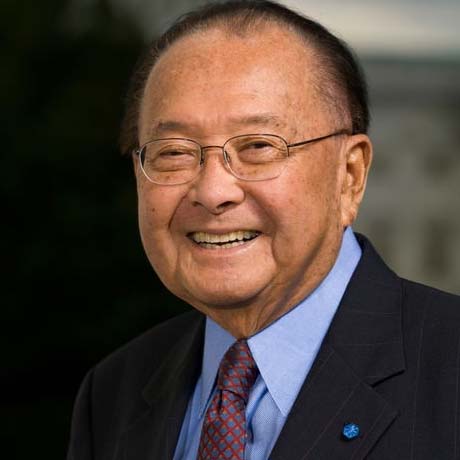
Senator
Daniel K. Inouye
1959: The first Japanese American elected to Congress
READ MOREDaniel K. Inouye
 1959: The first Japanese American elected to Congress
1959: The first Japanese American elected to Congress
Inouye was born in Honolulu, Hawaii, Sept. 7, 1924. He received his undergraduate degree from the University of Hawaii, and his law degree from George Washington University.
On Dec. 7, 1941, the fateful day of the Japanese attack on Pearl Harbor, 17-year-old Dan Inouye was one of the first Americans to handle civilian casualties in the Pacific war. He had taken medical aid training and was pressed into service as head of a first-aid litter team. He saw a "lot of blood" and did not go home for a week. During World War II, Inouye served in the U.S. Army's 442nd Regimental Combat Team. Composed of Soldiers of Japanese ancestry, the 442nd became one of the most decorated military units in U.S. history. For his combat heroism, which cost him his right arm, Inouye was awarded the Medal of Honor, the Distinguished Service Cross, the Bronze Star, and the Purple Heart with Cluster. He practiced law in Hawaii before entering territorial politics in 1954.
When Hawaii became the 50th state, Inouye became one of its first representatives in the U.S. Congress, then won election to the U.S. Senate in 1962. Sen. Inouye gained national distinction in the 1970s as a member of the Senate Watergate Committee and, in 1987, as chairman of the Senate Iran-Contra Committee. He was a long-time member of the Senate Appropriations Committee, which he chaired from 2009 to 2012, and also served as the Senate's president pro tempore from 2010 until his death in 2012. In 2013, Inouye was posthumously awarded the Presidential Medal of Freedom, becoming the first senator to receive both the Medal of Freedom and the Medal of Honor.
Senator Daniel K. Inouye
1959: The first Japanese American elected to Congress
Inouye was born in Honolulu, Hawaii, Sept. 7, 1924. He received his undergraduate degree from the University of Hawaii, and his law degree from George Washington University.
On Dec. 7, 1941, the fateful day of the Japanese attack on Pearl Harbor, 17-year-old Dan Inouye was one of the first Americans to handle civilian casualties in the Pacific war. He had taken medical aid training and was pressed into service as head of a first-aid litter team. He saw a "lot of blood" and did not go home for a week. During World War II, Inouye served in the U.S. Army's 442nd Regimental Combat Team. Composed of Soldiers of Japanese ancestry, the 442nd became one of the most decorated military units in U.S. history. For his combat heroism, which cost him his right arm, Inouye was awarded the Medal of Honor, the Distinguished Service Cross, the Bronze Star, and the Purple Heart with Cluster. He practiced law in Hawaii before entering territorial politics in 1954.
When Hawaii became the 50th state, Inouye became one of its first representatives in the U.S. Congress, then won election to the U.S. Senate in 1962. Sen. Inouye gained national distinction in the 1970s as a member of the Senate Watergate Committee and, in 1987, as chairman of the Senate Iran-Contra Committee. He was a long-time member of the Senate Appropriations Committee, which he chaired from 2009 to 2012, and also served as the Senate's president pro tempore from 2010 until his death in 2012. In 2013, Inouye was posthumously awarded the Presidential Medal of Freedom, becoming the first senator to receive both the Medal of Freedom and the Medal of Honor.
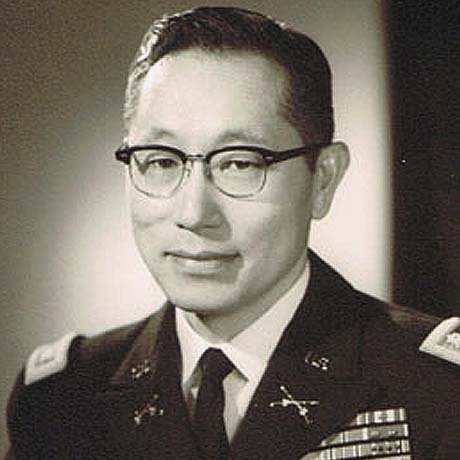
Colonel
Young-Oak Kim
1951: The first Asian American to lead a combat battalion in a war
READ MOREYoung-Oak Kim
 1951: The first Asian American to lead a combat battalion in a war
1951: The first Asian American to lead a combat battalion in a war
Col. Young-Oak Kim is also the only Korean American to be awarded the Distinguished Service Cross for his actions at the Battle of Anzio during World War II. Kim, having reenlisted and promoted to major, became the first ethnic minority to command a regular combat battalion, the first of the 31st Infantry. When then-2nd Lt. Young Oak Kim reported for duty at Camp Shelby, Miss., in Feb. 1943, the commander of the 100th Battalion (Separate), Lt. Col. Farrant Turner, offered him an immediate transfer because "Koreans and Japanese don't always get along." Kim refused on the spot,"You're wrong. They're Americans, I'm American, and we're going to fight for America." The young Korean American lieutenant was being both patriotic and pragmatic. Born in 1919 in downtown Los Angeles; amid Japanese, Chinese, Mexican, and Jewish immigrants, Kim knew his opportunities for advancement would be limited in a "white man's army. "If I wasn't with the 100th," Kim recalled many years later, "I would be a PR [Public Relations] officer or have some insignificant duty someplace else, because nobody was going to let me, as an Asian, command regular troops."
Colonel Young-Oak Kim
1951: The first Asian American to lead a combat battalion in a war
Col. Young-Oak Kim is also the only Korean American to be awarded the Distinguished Service Cross for his actions at the Battle of Anzio during World War II. Kim, having reenlisted and promoted to major, became the first ethnic minority to command a regular combat battalion, the first of the 31st Infantry. When then-2nd Lt. Young Oak Kim reported for duty at Camp Shelby, Miss., in Feb. 1943, the commander of the 100th Battalion (Separate), Lt. Col. Farrant Turner, offered him an immediate transfer because "Koreans and Japanese don't always get along." Kim refused on the spot,"You're wrong. They're Americans, I'm American, and we're going to fight for America." The young Korean American lieutenant was being both patriotic and pragmatic. Born in 1919 in downtown Los Angeles; amid Japanese, Chinese, Mexican, and Jewish immigrants, Kim knew his opportunities for advancement would be limited in a "white man's army. "If I wasn't with the 100th," Kim recalled many years later, "I would be a PR [Public Relations] officer or have some insignificant duty someplace else, because nobody was going to let me, as an Asian, command regular troops."
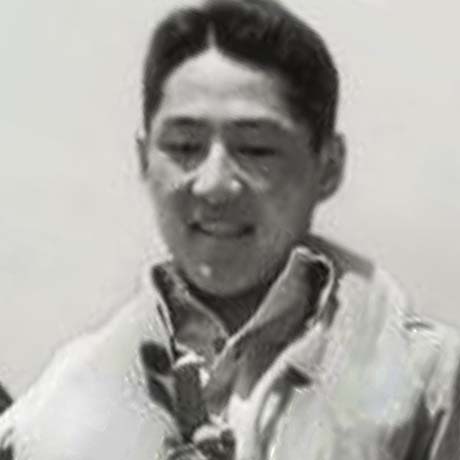
Captain
Fred Ohr
1941: Capt. Fred Ohr is the first and only American fighter ace of Korean descent
READ MOREFred Ohr
 1941: Capt. Fred Ohr is the first and only American fighter ace of Korean descent
1941: Capt. Fred Ohr is the first and only American fighter ace of Korean descent
Dr. Fred Ohr was born in Portland, Ore., in 1919, and became an aviation cadet in 1941. He was later assigned to the 2nd Fighter Squadron, 52nd Fighter Group in North Africa and Sicily as a fighter pilot flying Spitfires. He scored his first aerial combat victory flying a Spitfire in 1943. The rest of his victories came after the group transitioned to P-51s in 1944. Ohr ended his tour of duty as the squadron's commanding officer.
Then-Maj. Fred F. Ohr served with: 2nd Fighter Squadron, 52nd Fighter Group; 116th Cavalry Regiment, Idaho National Guard; 183rd Field Artillery; 115th Cavalry; 12th Air Force; 15th Air Force; and 68th Material Service Squadron. After the war, he returned to college in California. He studied at the University of California, Berkley, and Northwestern Dental School in Chicago. He established a career as a dental surgeon in Chicago.
Captain Fred Ohr
1941: Capt. Fred Ohr is the first and only American fighter ace of Korean descent
Dr. Fred Ohr was born in Portland, Ore., in 1919, and became an aviation cadet in 1941. He was later assigned to the 2nd Fighter Squadron, 52nd Fighter Group in North Africa and Sicily as a fighter pilot flying Spitfires. He scored his first aerial combat victory flying a Spitfire in 1943. The rest of his victories came after the group transitioned to P-51s in 1944. Ohr ended his tour of duty as the squadron's commanding officer.
Then-Maj. Fred F. Ohr served with: 2nd Fighter Squadron, 52nd Fighter Group; 116th Cavalry Regiment, Idaho National Guard; 183rd Field Artillery; 115th Cavalry; 12th Air Force; 15th Air Force; and 68th Material Service Squadron. After the war, he returned to college in California. He studied at the University of California, Berkley, and Northwestern Dental School in Chicago. He established a career as a dental surgeon in Chicago.
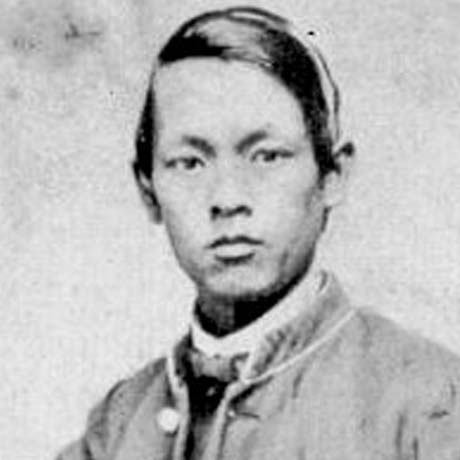
Corporal
Joseph L. Pierce
1862: Fought at the battle of Gettysburg
READ MOREJoseph L. Pierce
 1862: Fought at the battle of Gettysburg
1862: Fought at the battle of Gettysburg
Joseph L. Pierce was age 21 when he enlisted in the 14th Connecticut Infantry in August 1862. It's unclear how Pierce ended up in the United States. One story has it that his father sold him to Connecticut ship Captain Amos Peck. Another story was that his brother sold him. Still another was that Peck picked Pierce up while he was adrift in the South China Sea. Peck, a lifelong bachelor, turned the 10-year-old he called "Joe" over to his mother in Connecticut. In his youth, Joe went to school with the Peck's children and formally became Joseph Pierce in 1853. He picked up his last name from President Franklin Pierce. Pierce worked as a farmer in New Britain, Connecticut, at the time of his military enlistment. He listed his birthplace as Canton in Kwangtung Province, China.
Pierce's regiment participated in the Battle of Antietam, Md., Sept. 17, 1862. He suffered some sickness during his time around Washington and was in the hospital for a time. He was assigned to the Quartermaster Department for a bit and rejoined the 14th in time for the Battle of Chancellorsville, Va. in May 1863. The 14th had a distinguished role in the Gettysburg campaign. It fought on the north part of Cemetery Ridge, July 2, and was one of the units that helped repel Pickett's Charge. The 14th was primarily responsible for turning back Brig. Gen. James Pettigrew's North Carolina division. The 14th's regimental history says that during Pickett's charge, Pierce appeared "pig-tail and all, the only Chinese in the Army of the Potomac," but as history reflects, he wasn't in fact the only Soldier of Chinese descent. Today, you can see the 14th Memorial to the north of the grove of trees marking the high-water mark of the Confederacy.
Corporal Joseph L. Pierce
1862: Fought at the battle of Gettysburg
Joseph L. Pierce was age 21 when he enlisted in the 14th Connecticut Infantry in August 1862. It's unclear how Pierce ended up in the United States. One story has it that his father sold him to Connecticut ship Captain Amos Peck. Another story was that his brother sold him. Still another was that Peck picked Pierce up while he was adrift in the South China Sea. Peck, a lifelong bachelor, turned the 10-year-old he called "Joe" over to his mother in Connecticut. In his youth, Joe went to school with the Peck's children and formally became Joseph Pierce in 1853. He picked up his last name from President Franklin Pierce. Pierce worked as a farmer in New Britain, Connecticut, at the time of his military enlistment. He listed his birthplace as Canton in Kwangtung Province, China.
Pierce's regiment participated in the Battle of Antietam, Md., Sept. 17, 1862. He suffered some sickness during his time around Washington and was in the hospital for a time. He was assigned to the Quartermaster Department for a bit and rejoined the 14th in time for the Battle of Chancellorsville, Va. in May 1863. The 14th had a distinguished role in the Gettysburg campaign. It fought on the north part of Cemetery Ridge, July 2, and was one of the units that helped repel Pickett's Charge. The 14th was primarily responsible for turning back Brig. Gen. James Pettigrew's North Carolina division. The 14th's regimental history says that during Pickett's charge, Pierce appeared "pig-tail and all, the only Chinese in the Army of the Potomac," but as history reflects, he wasn't in fact the only Soldier of Chinese descent. Today, you can see the 14th Memorial to the north of the grove of trees marking the high-water mark of the Confederacy.
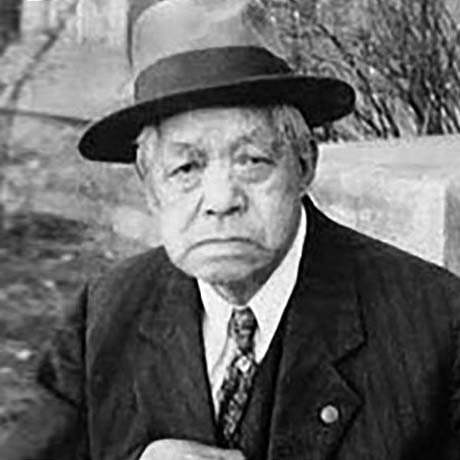
Private
Edward Day Cohota
1864: Fought in Civil War, Career Soldier
READ MOREEdward Day Cohota
 1864: Fought in Civil War, Career Soldier
1864: Fought in Civil War, Career Soldier
In 1845, Sargent S. Day, captain of the square-rigged merchant ship Cohota, left Shanghai, China, bound for Massachusetts. Two days from port, he discovered two little half-starved Chinese boys on board. The older boy died, but Day "adopted" the younger boy and named him Edward Day Cohota. Edward sailed the world with Captain and Mrs. Day until the captain retired to Gloucester, Mass., in 1857. He attended school and the other Day children treated him as a brother.
With the outbreak of the American Civil War, Cohota joined the 23rd Massachusetts Infantry. He fought in the Battle of Drury's Bluff near Richmond, Va., on May 16, 1864, and at the Battle of Cold Harbor, Va., June 3, 1864. He stayed with the Army of the Potomac through the end of the war. After the war, Cohota rejoined the Army and was stationed at Fort Randall, Dakota Territory. He married and had six children. He served in the Army for 30 years. He believed that his military service qualified him for U.S. citizenship. In 1882, Congress passed the Chinese Exclusion act, a legal measure enacted to cease the immigration of Chinese laborers into the United States. Because Cohota hadn't submitted his second set of naturalization papers prior to the passing of this Act, he ultimately was unable to gain American citizenship. Cohota died at the Battle Mountain Sanitarium for Veterans in Hot Springs, S.D., in 1935.
Private Edward Day Cohota
1864: Fought in Civil War, Career Soldier
In 1845, Sargent S. Day, captain of the square-rigged merchant ship Cohota, left Shanghai, China, bound for Massachusetts. Two days from port, he discovered two little half-starved Chinese boys on board. The older boy died, but Day "adopted" the younger boy and named him Edward Day Cohota. Edward sailed the world with Captain and Mrs. Day until the captain retired to Gloucester, Mass., in 1857. He attended school and the other Day children treated him as a brother.
With the outbreak of the American Civil War, Cohota joined the 23rd Massachusetts Infantry. He fought in the Battle of Drury's Bluff near Richmond, Va., on May 16, 1864, and at the Battle of Cold Harbor, Va., June 3, 1864. He stayed with the Army of the Potomac through the end of the war. After the war, Cohota rejoined the Army and was stationed at Fort Randall, Dakota Territory. He married and had six children. He served in the Army for 30 years. He believed that his military service qualified him for U.S. citizenship. In 1882, Congress passed the Chinese Exclusion act, a legal measure enacted to cease the immigration of Chinese laborers into the United States. Because Cohota hadn't submitted his second set of naturalization papers prior to the passing of this Act, he ultimately was unable to gain American citizenship. Cohota died at the Battle Mountain Sanitarium for Veterans in Hot Springs, S.D., in 1935.
Medal of Honor Recipients
The Medal of Honor is the nation's highest medal for valor in combat that can be awarded to members of the armed forces. It sometimes is referred to as the "Congressional Medal of Honor" because the President awards it on behalf of the Congress, but is not to be confused with the official title.
The medal was first authorized in 1861 for Sailors and Marines, and the following year, for Soldiers as well. Since then, more than 3,400 Medals of Honor have been awarded to members of all DOD services and the Coast Guard, as well as to a few civilians who distinguished themselves with valor. Those deserving of the medal sometimes are not recognized for years after their heroic actions. So it was for 22 Asian American World War II Soldiers, who finally received the Medal of Honor nearly six decades after the war, when former President Clinton bestowed the belated medals.

Specialist Five
Dennis Fujii
1971: Vietnam War
READ MOREDennis Fujii
 1971: Vietnam War
1971: Vietnam War
Spc. 5 Dennis Fujii enlisted in the U.S. Army in 1968 and soon after deployed to Vietnam. He spent his first months assigned to the 2nd Battalion, 35th Infantry, 4th Infantry Division as an assistant machine gunner. In February 1971, the 21-year-old Soldier was on his second Vietnam combat tour as a “dust off” medevac UH-1 helicopter crew chief with the 237th Medical Detachment, 61st Medical Battalion, 67th Medical Group, where he evacuated the wounded out of Laos. Fujii returned to Hawaii on Feb. 28, 1971, and was given a hero's welcome by Gov. John A. Burns. He later transferred to the Hawaii Army National Guard and the Pacific Army Reserve. He went on to work as a utilities and logistics technician for Global Associates at the Johnston Atoll Wildlife Refuge Island in the North Pacific. During a White House ceremony on July 5, 2022, President Joseph R. Biden awarded Fujii the Medal of Honor.
Related Articles
U.S. Army — Medal of Honor: Specialist Five Dennis M. Fujii
Specialist Five Dennis Fujii
1971: Vietnam War
Spc. 5 Dennis Fujii enlisted in the U.S. Army in 1968 and soon after deployed to Vietnam. He spent his first months assigned to the 2nd Battalion, 35th Infantry, 4th Infantry Division as an assistant machine gunner. In February 1971, the 21-year-old Soldier was on his second Vietnam combat tour as a “dust off” medevac UH-1 helicopter crew chief with the 237th Medical Detachment, 61st Medical Battalion, 67th Medical Group, where he evacuated the wounded out of Laos. Fujii returned to Hawaii on Feb. 28, 1971, and was given a hero's welcome by Gov. John A. Burns. He later transferred to the Hawaii Army National Guard and the Pacific Army Reserve. He went on to work as a utilities and logistics technician for Global Associates at the Johnston Atoll Wildlife Refuge Island in the North Pacific. During a White House ceremony on July 5, 2022, President Joseph R. Biden awarded Fujii the Medal of Honor.
Related Articles
U.S. Army — Medal of Honor: Specialist Five Dennis M. Fujii

Staff Sergeant
Edward Kaneshiro
1967: Vietnam War
READ MOREEdward Kaneshiro
 1967: Vietnam War
1967: Vietnam War
Staff Sgt. Edward Kaneshiro enlisted in the U.S. Army in 1959 and upon completion of advanced individual training as an infantryman, he was assigned to Company C, 1st Battalion, 27th Infantry Regiment, 25th Infantry Division, at Schofield Barracks in Hawaii. He served in non-combat overseas tours in Okinawa, Japan and South Korea, and was then assigned Troop C, 1st Squadron, 9th Cavalry Regiment, 1st Cavalry Division. He deployed to Vietnam as a squad leader within his platoon.During a mission in Kim Son Valley, Vietnam, in December 1966, his unit came under fire from North Vietnamese troops. Kaneshiro crawled forward to attack, using six grenades and an M16 rifle. This brave and selfless act not only saved the lives of U.S. Soldiers, but also resulted in success for the next mission of the Army forces. Kaneshiro was later killed in action on March 6, 1967, as a result of a hostile gunshot wound. Kaneshiro left behind his wife Mitsuko and their five children. During a White House ceremony on July 5, 2022, President Joseph R. Biden posthumously awarded Kaneshiro the Medal of Honor, which was received by his son, John Kaneshiro.
Related Articles
U.S. Army — Medal of Honor: Staff Sergeant Edward Kaneshiro
Staff Sergeant Edward Kaneshiro
1967: Vietnam War
Staff Sgt. Edward Kaneshiro enlisted in the U.S. Army in 1959 and upon completion of advanced individual training as an infantryman, he was assigned to Company C, 1st Battalion, 27th Infantry Regiment, 25th Infantry Division, at Schofield Barracks in Hawaii. He served in non-combat overseas tours in Okinawa, Japan and South Korea, and was then assigned Troop C, 1st Squadron, 9th Cavalry Regiment, 1st Cavalry Division. He deployed to Vietnam as a squad leader within his platoon.During a mission in Kim Son Valley, Vietnam, in December 1966, his unit came under fire from North Vietnamese troops. Kaneshiro crawled forward to attack, using six grenades and an M16 rifle. This brave and selfless act not only saved the lives of U.S. Soldiers, but also resulted in success for the next mission of the Army forces. Kaneshiro was later killed in action on March 6, 1967, as a result of a hostile gunshot wound. Kaneshiro left behind his wife Mitsuko and their five children. During a White House ceremony on July 5, 2022, President Joseph R. Biden posthumously awarded Kaneshiro the Medal of Honor, which was received by his son, John Kaneshiro.
Related Articles
U.S. Army — Medal of Honor: Staff Sergeant Edward Kaneshiro
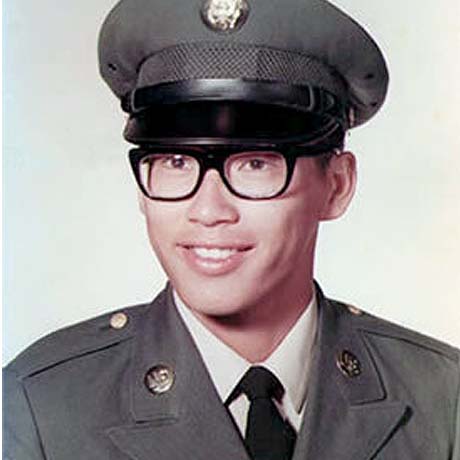
Corporal
Terry "Teruo" Kawamura
1969: Vietnam War
READ MORETerry "Teruo" Kawamura
 1969: Vietnam War
1969: Vietnam War
Cpl. Terry Kawamura served in 173rd Engineer Company, 173d Airborne Brigade, Republic of Vietnam. He was posthumously awarded the Medal of Honor for actions in Camp Radcliff, Republic of Vietnam, March 20, 1969. Citation: For conspicuous gallantry and intrepidity in action at the risk of his life above and beyond the call of duty. Corporal Kawamura distinguished himself by heroic action while serving as a member of the 173d Engineer Company. An enemy demolition team infiltrated the unit quarters area and opened fire with automatic weapons. Disregarding the intense fire, Corporal Kawamura ran for his weapon. At that moment, a violent explosion tore a hole in the roof and stunned the occupants of the room. Corporal Kawamura jumped to his feet, secured his weapon and, as he ran toward the door to return the enemy fire, he observed that another explosive charge had been thrown through the hole in the roof to the floor. He immediately realized that 2 stunned fellow soldiers were in great peril and shouted a warning. Although in a position to escape, Corporal Kawamura unhesitatingly wheeled around and threw himself on the charge. In complete disregarding his safety, Corporal Kawamura prevented serious injury or death to several members of his unit. The extraordinary courage and selflessness displayed by Corporal Kawamura are in the highest traditions of the military service and reflect great credit upon himself, his unit, and the U.S. Army.
Related Articles
Congressional Medal of Honor Society
Corporal Terry "Teruo" Kawamura
1969: Vietnam War
Cpl. Terry Kawamura served in 173rd Engineer Company, 173d Airborne Brigade, Republic of Vietnam. He was posthumously awarded the Medal of Honor for actions in Camp Radcliff, Republic of Vietnam, March 20, 1969. Citation: For conspicuous gallantry and intrepidity in action at the risk of his life above and beyond the call of duty. Corporal Kawamura distinguished himself by heroic action while serving as a member of the 173d Engineer Company. An enemy demolition team infiltrated the unit quarters area and opened fire with automatic weapons. Disregarding the intense fire, Corporal Kawamura ran for his weapon. At that moment, a violent explosion tore a hole in the roof and stunned the occupants of the room. Corporal Kawamura jumped to his feet, secured his weapon and, as he ran toward the door to return the enemy fire, he observed that another explosive charge had been thrown through the hole in the roof to the floor. He immediately realized that 2 stunned fellow soldiers were in great peril and shouted a warning. Although in a position to escape, Corporal Kawamura unhesitatingly wheeled around and threw himself on the charge. In complete disregarding his safety, Corporal Kawamura prevented serious injury or death to several members of his unit. The extraordinary courage and selflessness displayed by Corporal Kawamura are in the highest traditions of the military service and reflect great credit upon himself, his unit, and the U.S. Army.
Related Articles
Congressional Medal of Honor Society
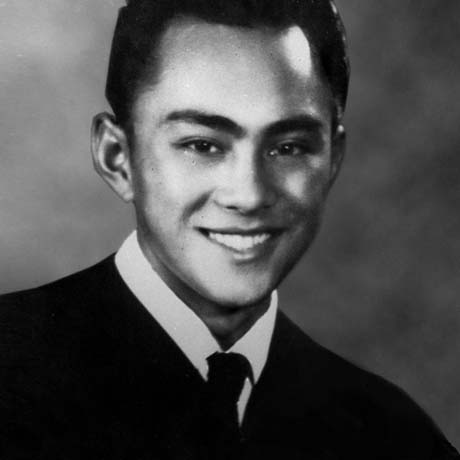
Brigadier General
Rodney J.T. Yano
1969: Vietnam War
READ MORERodney J.T. Yano
 1969: Vietnam War
1969: Vietnam War
Sgt. 1st Class First Class Rodney J.T. Yano served in the Air Cavalry Troop, 11th Armored Cavalry Regiment. He was posthumously awarded the Medal of Honor for his actions near Bien Hao, Republic of Vietnam, Jan. 1, 1969. Citation: Sfc. Yano distinguished himself while serving with the Air Cavalry Troop. Sfc. Yano was performing the duties of crew chief aboard the troop's command-and-control helicopter during action against enemy forces entrenched in dense jungle. From an exposed position in the face of intense small arms and antiaircraft fire he delivered suppressive fire upon the enemy forces and marked their positions with smoke and white phosphorous grenades, thus enabling his troop commander to direct accurate and effective artillery fire against the hostile emplacements. A grenade, exploding prematurely, covered him with burning phosphorous, and left him severely wounded. Flaming fragments within the helicopter caused supplies and ammunition to detonate. Dense white smoke filled the aircraft, obscuring the pilot's vision and causing him to lose control. Although having the use of only one arm and being partially blinded by the initial explosion, Sfc. Yano completely disregarded his welfare and began hurling blazing ammunition from the helicopter. In so doing he inflicted additional wounds upon himself, yet he persisted until the danger was past. Sfc. Yano's indomitable courage and profound concern for his comrades averted loss of life and additional injury to the rest of the crew. By his conspicuous gallantry at the cost of his life, in the highest traditions of the military service, Sfc. Yano has reflected great credit on himself, his unit, and the U.S. Army.
Related Articles
Congressional Medal of Honor Society .
Rodney J. T. Yano Non-Commissioned Officer of the Year Award
Brigadier General Rodney J.T. Yano
1969: Vietnam War
Sgt. 1st Class First Class Rodney J.T. Yano served in the Air Cavalry Troop, 11th Armored Cavalry Regiment. He was posthumously awarded the Medal of Honor for his actions near Bien Hao, Republic of Vietnam, Jan. 1, 1969. Citation: Sfc. Yano distinguished himself while serving with the Air Cavalry Troop. Sfc. Yano was performing the duties of crew chief aboard the troop's command-and-control helicopter during action against enemy forces entrenched in dense jungle. From an exposed position in the face of intense small arms and antiaircraft fire he delivered suppressive fire upon the enemy forces and marked their positions with smoke and white phosphorous grenades, thus enabling his troop commander to direct accurate and effective artillery fire against the hostile emplacements. A grenade, exploding prematurely, covered him with burning phosphorous, and left him severely wounded. Flaming fragments within the helicopter caused supplies and ammunition to detonate. Dense white smoke filled the aircraft, obscuring the pilot's vision and causing him to lose control. Although having the use of only one arm and being partially blinded by the initial explosion, Sfc. Yano completely disregarded his welfare and began hurling blazing ammunition from the helicopter. In so doing he inflicted additional wounds upon himself, yet he persisted until the danger was past. Sfc. Yano's indomitable courage and profound concern for his comrades averted loss of life and additional injury to the rest of the crew. By his conspicuous gallantry at the cost of his life, in the highest traditions of the military service, Sfc. Yano has reflected great credit on himself, his unit, and the U.S. Army.
Related Articles
Congressional Medal of Honor Society .
Rodney J. T. Yano Non-Commissioned Officer of the Year Award
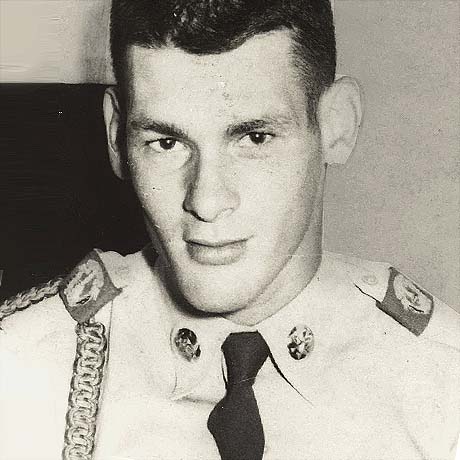
Staff Sergeant
Elmelindo R. Smith
1967: Vietnam War
READ MOREElmelindo R. Smith
 1967: Vietnam War
1967: Vietnam War
Then-Staff Sgt. Elmelindo R. Smith, served as the platoon sergeant of 1st Platoon, Company C, 2nd Battalion, 8th Infantry, 4th Infantry Division. He was posthumously awarded the Medal of Honor for actions on Feb. 16, 1967. Citation: For conspicuous gallantry and intrepidity at the risk of his life above and beyond the call of duty. During a reconnaissance patrol, his platoon was suddenly engaged by intense machine-gun fire hemming in the platoon on three sides. A defensive perimeter was hastily established, but the enemy added mortar and rocket fire to the deadly fusillade and assaulted the position from several directions. With complete disregard for his safety, P/Sgt. Smith moved through the deadly fire along the defensive line, positioning soldiers, distributing ammunition and encouraging his men to repeal the enemy attack. Struck to the ground by enemy fire which caused a severe shoulder wound, he regained his feet, killed the enemy soldier and continued to move about the perimeter. He was again wounded in the shoulder and stomach but continued moving on his knees to assist in the defense. Noting the enemy massing at a weakened point on the perimeter, he crawled into the open and poured deadly fire into the enemy ranks. As he crawled on, he was struck by a rocket. Moments later, he regained consciousness, and drawing on his fast dwindling strength, continued to crawl from man to man. When he could move no farther, he chose to remain in the open where he could alert the perimeter to the approaching enemy. P/Sgt. Smith perished, never relenting in his determined effort against the enemy. The valorous acts and heroic leadership of this outstanding soldier inspired those remaining members of his platoon to beat back the enemy assaults. P/Sgt. Smith's gallant actions were in keeping with the highest traditions of the U.S. Army and they reflect great credit upon him and the Armed Forces of his country.
Related Articles
Congressional Medal of Honor Society .
Staff Sergeant Elmelindo R. Smith
1967: Vietnam War
Then-Staff Sgt. Elmelindo R. Smith, served as the platoon sergeant of 1st Platoon, Company C, 2nd Battalion, 8th Infantry, 4th Infantry Division. He was posthumously awarded the Medal of Honor for actions on Feb. 16, 1967. Citation: For conspicuous gallantry and intrepidity at the risk of his life above and beyond the call of duty. During a reconnaissance patrol, his platoon was suddenly engaged by intense machine-gun fire hemming in the platoon on three sides. A defensive perimeter was hastily established, but the enemy added mortar and rocket fire to the deadly fusillade and assaulted the position from several directions. With complete disregard for his safety, P/Sgt. Smith moved through the deadly fire along the defensive line, positioning soldiers, distributing ammunition and encouraging his men to repeal the enemy attack. Struck to the ground by enemy fire which caused a severe shoulder wound, he regained his feet, killed the enemy soldier and continued to move about the perimeter. He was again wounded in the shoulder and stomach but continued moving on his knees to assist in the defense. Noting the enemy massing at a weakened point on the perimeter, he crawled into the open and poured deadly fire into the enemy ranks. As he crawled on, he was struck by a rocket. Moments later, he regained consciousness, and drawing on his fast dwindling strength, continued to crawl from man to man. When he could move no farther, he chose to remain in the open where he could alert the perimeter to the approaching enemy. P/Sgt. Smith perished, never relenting in his determined effort against the enemy. The valorous acts and heroic leadership of this outstanding soldier inspired those remaining members of his platoon to beat back the enemy assaults. P/Sgt. Smith's gallant actions were in keeping with the highest traditions of the U.S. Army and they reflect great credit upon him and the Armed Forces of his country.
Related Articles
Congressional Medal of Honor Society .
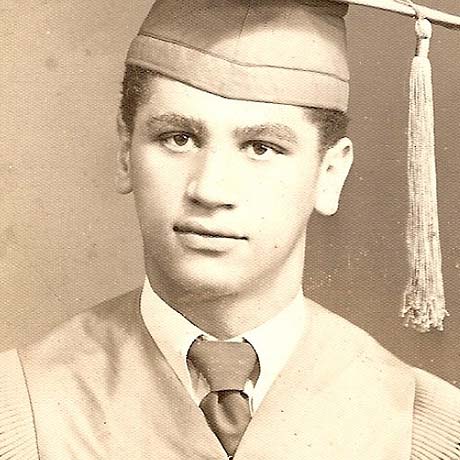
Private First Class
Anthony T. Kaho'ohanohano
1951: Korean War
READ MOREAnthony T. Kaho'ohanohano
 1951: Korean War
1951: Korean War
Pfc. Anthony T. Kaho'ohanohano, served in Company H, 17th Infantry Regiment, 7th Infantry Division. He was awarded the Medal of Honor for his action against the enemy in the vicinity of Chupa-ri, Korea, Sept. 1, 1951. Citation: For conspicuous gallantry and intrepidity at the risk of his life above and beyond the call of duty Private First Class Anthony T. Kaho'ohanohano, Company H, 17th Infantry Regiment, 7th Infantry Division, distinguished himself by extraordinary heroism in action against the enemy in the vicinity of Chupa-ri, Korea, on 1 September 1951. On that date, Private First Class Kaho'ohanohano was in charge of a machine-gun squad supporting the defensive positioning of Company F when a numerically superior enemy force launched a fierce attack. Because of the enemy's overwhelming numbers, friendly troops were forced to execute a limited withdrawal. As the men fell back, Private First Class Kaho'ohanohano ordered his squad to take up more defensible positions and provide covering fire for the withdrawing friendly force. Although having been wounded in the shoulder during the initial enemy assault, Private First Class Kaho'ohanohano gathered a supply of grenades and ammunition and returned to his original position to face the enemy alone. As the hostile troops concentrated their strength against his emplacement in an effort to overrun it, Private First Class Kaho'ohanohano fought fiercely and courageously, delivering deadly accurate fire into the ranks of the onrushing enemy. When his ammunition was depleted, he engaged the enemy in hand-to-hand combat until he was killed. Private First Class Kaho'ohanohano's heroic stand so inspired his comrades that they launched a counterattack that completely repulsed the enemy. Upon reaching Private First Class Kaho'ohanohano's emplacement, friendly troops discovered 11 enemy soldiers lying dead in front of the emplacement and two inside it, killed in hand-to-hand combat. Private First Class Kaho'ohanohano's extraordinary heroism and selfless devotion to duty are in keeping with the finest traditions of military service and reflect great credit upon himself, the 7th Infantry Division, and the United States Army.
Related Articles
Congressional Medal of Honor Society .
Army.mil: Medal of Honor - Pfc. Anthony T. Kaho'ohanohano
Private First Class Anthony T. Kaho'ohanohano
1951: Korean War
Pfc. Anthony T. Kaho'ohanohano, served in Company H, 17th Infantry Regiment, 7th Infantry Division. He was awarded the Medal of Honor for his action against the enemy in the vicinity of Chupa-ri, Korea, Sept. 1, 1951. Citation: For conspicuous gallantry and intrepidity at the risk of his life above and beyond the call of duty Private First Class Anthony T. Kaho'ohanohano, Company H, 17th Infantry Regiment, 7th Infantry Division, distinguished himself by extraordinary heroism in action against the enemy in the vicinity of Chupa-ri, Korea, on 1 September 1951. On that date, Private First Class Kaho'ohanohano was in charge of a machine-gun squad supporting the defensive positioning of Company F when a numerically superior enemy force launched a fierce attack. Because of the enemy's overwhelming numbers, friendly troops were forced to execute a limited withdrawal. As the men fell back, Private First Class Kaho'ohanohano ordered his squad to take up more defensible positions and provide covering fire for the withdrawing friendly force. Although having been wounded in the shoulder during the initial enemy assault, Private First Class Kaho'ohanohano gathered a supply of grenades and ammunition and returned to his original position to face the enemy alone. As the hostile troops concentrated their strength against his emplacement in an effort to overrun it, Private First Class Kaho'ohanohano fought fiercely and courageously, delivering deadly accurate fire into the ranks of the onrushing enemy. When his ammunition was depleted, he engaged the enemy in hand-to-hand combat until he was killed. Private First Class Kaho'ohanohano's heroic stand so inspired his comrades that they launched a counterattack that completely repulsed the enemy. Upon reaching Private First Class Kaho'ohanohano's emplacement, friendly troops discovered 11 enemy soldiers lying dead in front of the emplacement and two inside it, killed in hand-to-hand combat. Private First Class Kaho'ohanohano's extraordinary heroism and selfless devotion to duty are in keeping with the finest traditions of military service and reflect great credit upon himself, the 7th Infantry Division, and the United States Army.
Related Articles
Congressional Medal of Honor Society .
Army.mil: Medal of Honor - Pfc. Anthony T. Kaho'ohanohano
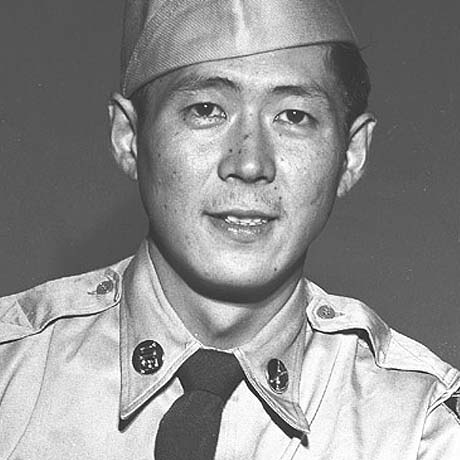
Corporal
Hiroshi Miyamura
1951: Korean War
READ MOREHiroshi Miyamura
 1951: Korean War
1951: Korean War
Cpl. Hiroshi H. Miyamura served in Company H, 7th Infantry Regiment, 3rd Infantry Division. He was awarded the Medal of Honor for his actions near Taejon-ni, Korea, on April 24 and 25, 1951. Citation: Cpl. Miyamura, a member of Company H, distinguished himself by conspicuous gallantry and intrepidity above and beyond the call of duty in action against the enemy. On the night of April 24, Company H was occupying a defensive position when the enemy fanatically attacked threatening to overrun the position. Cpl. Miyamura, a machinegun squad leader, aware of the imminent danger to his men unhesitatingly jumped from his shelter wielding his bayonet in close hand-to-hand combat killing approximately 10 of the enemy. Returning to his position, he administered first aid to the wounded and directed their evacuation. As another savage assault hit the line, he manned his machine-gun and delivered withering fire until his ammunition was expended. He ordered the squad to withdraw while he stayed behind to render the gun inoperative. He then bayoneted his way through infiltrated enemy soldiers to a second gun emplacement and assisted in its operation. When the intensity of the attack necessitated the withdrawal of the company Cpl. Miyamura ordered his men to fall back while he remained to cover their movement. He killed more than 50 of the enemy before his ammunition was depleted and he was severely wounded. He maintained his magnificent stand despite his painful wounds, continuing to repel the attack until his position was overrun. When last seen he was fighting ferociously against an overwhelming number of enemy soldiers. Cpl. Miyamura's indomitable heroism and consummate devotion to duty reflect the utmost glory on himself and uphold the illustrious traditions on the military service.
Related Articles
Congressional Medal of Honor Society .
Army.mil: Fort Stewart hosts Gate Renaming for three legendary Dogface Soldiers
Corporal Hiroshi Miyamura
1951: Korean War
Cpl. Hiroshi H. Miyamura served in Company H, 7th Infantry Regiment, 3rd Infantry Division. He was awarded the Medal of Honor for his actions near Taejon-ni, Korea, on April 24 and 25, 1951. Citation: Cpl. Miyamura, a member of Company H, distinguished himself by conspicuous gallantry and intrepidity above and beyond the call of duty in action against the enemy. On the night of April 24, Company H was occupying a defensive position when the enemy fanatically attacked threatening to overrun the position. Cpl. Miyamura, a machinegun squad leader, aware of the imminent danger to his men unhesitatingly jumped from his shelter wielding his bayonet in close hand-to-hand combat killing approximately 10 of the enemy. Returning to his position, he administered first aid to the wounded and directed their evacuation. As another savage assault hit the line, he manned his machine-gun and delivered withering fire until his ammunition was expended. He ordered the squad to withdraw while he stayed behind to render the gun inoperative. He then bayoneted his way through infiltrated enemy soldiers to a second gun emplacement and assisted in its operation. When the intensity of the attack necessitated the withdrawal of the company Cpl. Miyamura ordered his men to fall back while he remained to cover their movement. He killed more than 50 of the enemy before his ammunition was depleted and he was severely wounded. He maintained his magnificent stand despite his painful wounds, continuing to repel the attack until his position was overrun. When last seen he was fighting ferociously against an overwhelming number of enemy soldiers. Cpl. Miyamura's indomitable heroism and consummate devotion to duty reflect the utmost glory on himself and uphold the illustrious traditions on the military service.
Related Articles
Congressional Medal of Honor Society .
Army.mil: Fort Stewart hosts Gate Renaming for three legendary Dogface Soldiers
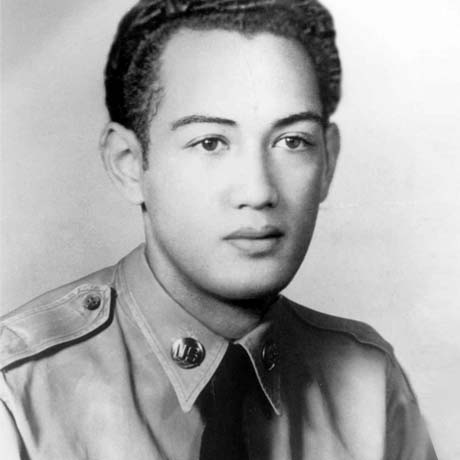
Private First Class
Herbert K. Pililaau
1951: Korean War
READ MOREHerbert K. Pililaau
 1951: Korean War
1951: Korean War
Pfc. Herbert K. Pililaau served in Company C, 23rd Infantry Regiment, 2nd Infantry Division. He was posthumously awarded the Medal of Honor for his actions near Pia-ri, Korea on Sept. 17, 1951. Citation: Pfc. Pililaau, a member of Company C, distinguished himself by conspicuous gallantry and outstanding courage above and beyond the call of duty in action against the enemy. The enemy sent wave after wave of fanatical troops against his platoon which held a key terrain feature on "Heartbreak Ridge." Valiantly defending its position, the unit repulsed each attack until ammunition became practically exhausted and it was ordered to withdraw to a new position. Voluntarily remaining behind to cover the withdrawal, Pfc. Pililaau fired his automatic weapon into the ranks of the assailants, threw all his grenades and, with ammunition exhausted, closed with the foe in hand-to-hand combat, courageously fighting with his trench knife and bare fists until finally overcome and mortally wounded. When the position was subsequently retaken, more than 40 enemy dead were counted in the area he had so valiantly defended. His heroic devotion to duty, indomitable fighting spirit, and gallant self-sacrifice reflect the highest credit upon himself, the infantry, and the U.S. Army.
Related Articles
Congressional Medal of Honor Society .
Army.mil: Hawaii native son immortalized for giving ultimate sacrifice
Private First Class Herbert K. Pililaau
1951: Korean War
Pfc. Herbert K. Pililaau served in Company C, 23rd Infantry Regiment, 2nd Infantry Division. He was posthumously awarded the Medal of Honor for his actions near Pia-ri, Korea on Sept. 17, 1951. Citation: Pfc. Pililaau, a member of Company C, distinguished himself by conspicuous gallantry and outstanding courage above and beyond the call of duty in action against the enemy. The enemy sent wave after wave of fanatical troops against his platoon which held a key terrain feature on "Heartbreak Ridge." Valiantly defending its position, the unit repulsed each attack until ammunition became practically exhausted and it was ordered to withdraw to a new position. Voluntarily remaining behind to cover the withdrawal, Pfc. Pililaau fired his automatic weapon into the ranks of the assailants, threw all his grenades and, with ammunition exhausted, closed with the foe in hand-to-hand combat, courageously fighting with his trench knife and bare fists until finally overcome and mortally wounded. When the position was subsequently retaken, more than 40 enemy dead were counted in the area he had so valiantly defended. His heroic devotion to duty, indomitable fighting spirit, and gallant self-sacrifice reflect the highest credit upon himself, the infantry, and the U.S. Army.
Related Articles
Congressional Medal of Honor Society .
Army.mil: Hawaii native son immortalized for giving ultimate sacrifice
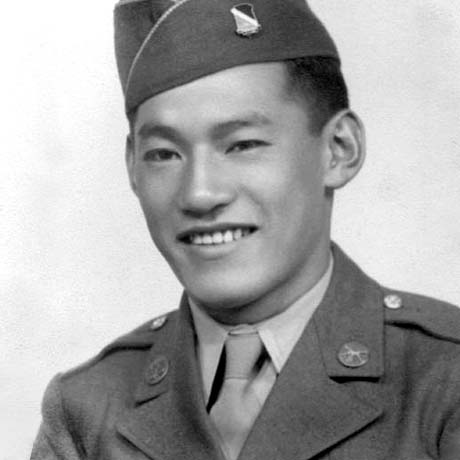
Private
Joe Hayashi
1945: World War II
READ MOREJoe Hayashi
 1945: World War II
1945: World War II
Pvt. Joe Hayashi served in the 442nd Regimental Combat Team. He was posthumously awarded the Distinguished Service Cross that was upgraded to the Medal of Honor for his actions near Tendola, Italy, April 20 and 22, 1945. Citation: Private Joe Hayashi distinguished himself by extraordinary heroism in action on 20 and 22 April 1945, near Tendola, Italy. On 20 April 1945, ordered to attack a strongly defended hill that commanded all approaches to the village of Tendola, Private Hayashi skillfully led his men to a point within 75 yards of enemy positions before they were detected and fired upon. After dragging his wounded comrades to safety, he returned alone and exposed himself to small arms fire in order to direct and adjust mortar fire against hostile emplacements. Boldly attacking the hill with the remaining men of his squad, he attained his objective and discovered that the mortars had neutralized three machine guns, killed 27 men, and wounded many others. On 22 April 1945, attacking the village of Tendola, Private Hayashi maneuvered his squad up a steep, terraced hill to within 100 yards of the enemy. Crawling under intense fire to a hostile machine gun position, he threw a grenade, killing one enemy soldier and forcing the other members of the gun crew to surrender. Seeing four enemy machine guns delivering deadly fire upon other elements of his platoon, he threw another grenade, destroying a machine gun nest. He then crawled to the right flank of another machine gun position where he killed four enemy soldiers and forced the others to flee. Attempting to pursue the enemy, he was mortally wounded by a burst of machine pistol fire. The dauntless courage and exemplary leadership of Private Hayashi enabled his company to attain its objective. Private Hayashi's extraordinary heroism and devotion to duty are in keeping with the highest traditions of military service and reflect great credit on him, his unit, and the United States Army.
Related Articles
Congressional Medal of Honor Society
Private Joe Hayashi
1945: World War II
Pvt. Joe Hayashi served in the 442nd Regimental Combat Team. He was posthumously awarded the Distinguished Service Cross that was upgraded to the Medal of Honor for his actions near Tendola, Italy, April 20 and 22, 1945. Citation: Private Joe Hayashi distinguished himself by extraordinary heroism in action on 20 and 22 April 1945, near Tendola, Italy. On 20 April 1945, ordered to attack a strongly defended hill that commanded all approaches to the village of Tendola, Private Hayashi skillfully led his men to a point within 75 yards of enemy positions before they were detected and fired upon. After dragging his wounded comrades to safety, he returned alone and exposed himself to small arms fire in order to direct and adjust mortar fire against hostile emplacements. Boldly attacking the hill with the remaining men of his squad, he attained his objective and discovered that the mortars had neutralized three machine guns, killed 27 men, and wounded many others. On 22 April 1945, attacking the village of Tendola, Private Hayashi maneuvered his squad up a steep, terraced hill to within 100 yards of the enemy. Crawling under intense fire to a hostile machine gun position, he threw a grenade, killing one enemy soldier and forcing the other members of the gun crew to surrender. Seeing four enemy machine guns delivering deadly fire upon other elements of his platoon, he threw another grenade, destroying a machine gun nest. He then crawled to the right flank of another machine gun position where he killed four enemy soldiers and forced the others to flee. Attempting to pursue the enemy, he was mortally wounded by a burst of machine pistol fire. The dauntless courage and exemplary leadership of Private Hayashi enabled his company to attain its objective. Private Hayashi's extraordinary heroism and devotion to duty are in keeping with the highest traditions of military service and reflect great credit on him, his unit, and the United States Army.
Related Articles
Congressional Medal of Honor Society
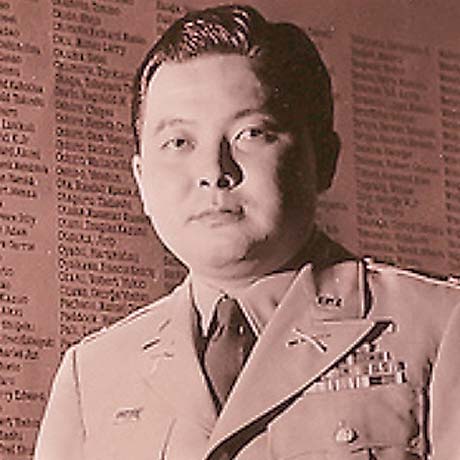
Second Lieutenant
Daniel K. Inouye
1945: World War II
READ MOREDaniel K. Inouye
 1945: World War II
1945: World War II
Then-2nd Lt. Daniel K. Inouye served in the 442nd Infantry Regiment. He was posthumously awarded the Distinguished Service Cross that was upgraded to the Medal of Honor for his actions in the vicinity of San Terenzo, Italy, April 21, 1945. Citation: Second Lieutenant Daniel K. Inouye distinguished himself by extraordinary heroism in action on 21 April 1945, in the vicinity of San Terenzo, Italy. While attacking a defended ridge guarding an important road junction, Second Lieutenant Inouye skillfully directed his platoon through a hail of automatic weapon and small arms fire, in a swift enveloping movement that resulted in the capture of an artillery and mortar post and brought his men to within 40 yards of the hostile force. Emplaced in bunkers and rock formations, the enemy halted the advance with crossfire from three machine guns. With complete disregard for his personal safety, Second Lieutenant Inouye crawled up the treacherous slope to within five yards of the nearest machine gun and hurled two grenades, destroying the emplacement. Before the enemy could retaliate, he stood up and neutralized a second machine gun nest. Although wounded by a sniper's bullet, he continued to engage other hostile positions at close range until an exploding grenade shattered his right arm. Despite the intense pain, he refused evacuation and continued to direct his platoon until enemy resistance was broken and his men were again deployed in defensive positions. In the attack, 25 enemy soldiers were killed and eight others captured. By his gallant, aggressive tactics and by his indomitable leadership, Second Lieutenant Inouye enabled his platoon to advance through formidable resistance, and was instrumental in the capture of the ridge. Second Lieutenant Inouye's extraordinary heroism and devotion to duty are in keeping with the highest traditions of military service and reflect great credit on him, his unit, and the United States Army. "One doesn't become a soldier in a week - it takes training, study & discipline. There is no question that the finest Army in the world is found in the United States."
Related Articles
Congressional Medal of Honor Society .
Army.mil: Hawaii Senator Inouye Awarded National Honor
Army.mil: Sen. Inouye receives Medal of Honor flag
Second Lieutenant Daniel K. Inouye
1945: World War II
Then-2nd Lt. Daniel K. Inouye served in the 442nd Infantry Regiment. He was posthumously awarded the Distinguished Service Cross that was upgraded to the Medal of Honor for his actions in the vicinity of San Terenzo, Italy, April 21, 1945. Citation: Second Lieutenant Daniel K. Inouye distinguished himself by extraordinary heroism in action on 21 April 1945, in the vicinity of San Terenzo, Italy. While attacking a defended ridge guarding an important road junction, Second Lieutenant Inouye skillfully directed his platoon through a hail of automatic weapon and small arms fire, in a swift enveloping movement that resulted in the capture of an artillery and mortar post and brought his men to within 40 yards of the hostile force. Emplaced in bunkers and rock formations, the enemy halted the advance with crossfire from three machine guns. With complete disregard for his personal safety, Second Lieutenant Inouye crawled up the treacherous slope to within five yards of the nearest machine gun and hurled two grenades, destroying the emplacement. Before the enemy could retaliate, he stood up and neutralized a second machine gun nest. Although wounded by a sniper's bullet, he continued to engage other hostile positions at close range until an exploding grenade shattered his right arm. Despite the intense pain, he refused evacuation and continued to direct his platoon until enemy resistance was broken and his men were again deployed in defensive positions. In the attack, 25 enemy soldiers were killed and eight others captured. By his gallant, aggressive tactics and by his indomitable leadership, Second Lieutenant Inouye enabled his platoon to advance through formidable resistance, and was instrumental in the capture of the ridge. Second Lieutenant Inouye's extraordinary heroism and devotion to duty are in keeping with the highest traditions of military service and reflect great credit on him, his unit, and the United States Army. "One doesn't become a soldier in a week - it takes training, study & discipline. There is no question that the finest Army in the world is found in the United States."
Related Articles
Congressional Medal of Honor Society .
Army.mil: Hawaii Senator Inouye Awarded National Honor
Army.mil: Sen. Inouye receives Medal of Honor flag
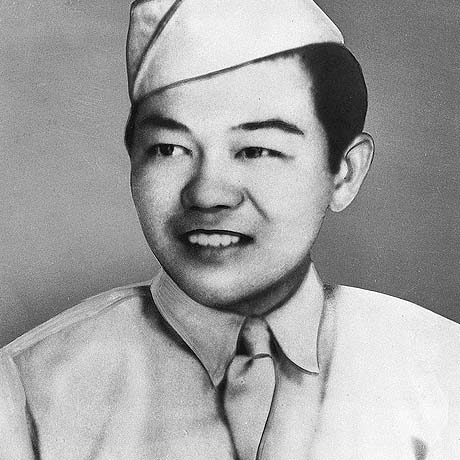
Private First Class
Sadao S. Munemori
1945: World War II
READ MORESadao S. Munemori
 1945: World War II
1945: World War II
Pfc. Sadao S. Munemori served in Company A, 100th Infantry Battalion, 442d Combat Team. He was posthumously awarded the Distinguished Service Cross that was upgraded to the Medal of Honor for his actions near Seravezza, Italy, April 5, 1945. Citation: He fought with great gallantry and intrepidity near Seravezza, Italy. When his unit was pinned down by grazing fire from the enemy's strong mountain defense and command of the squad devolved on him with the wounding of its regular leader, he made frontal, l-man attacks through direct fire and knocked out 2 machineguns with grenades Withdrawing under murderous fire and showers of grenades from other enemy emplacements, he had nearly reached a shell crater occupied by 2 of his men when an unexploded grenade bounced on his helmet and rolled toward his helpless comrades. He arose into the withering fire, dived for the missile and smothered its blast with his body. By his swift, supremely heroic action Private First Class Munemori saved 2 of his men at the cost of his own life and did much to clear the path for his company's victorious advance.
Related Articles
Congressional Medal of Honor Society.
Army.mil: Heroic actions led Soldier to become first Nisei Medal of Honor recipient
Private First Class Sadao S. Munemori
1945: World War II
Pfc. Sadao S. Munemori served in Company A, 100th Infantry Battalion, 442d Combat Team. He was posthumously awarded the Distinguished Service Cross that was upgraded to the Medal of Honor for his actions near Seravezza, Italy, April 5, 1945. Citation: He fought with great gallantry and intrepidity near Seravezza, Italy. When his unit was pinned down by grazing fire from the enemy's strong mountain defense and command of the squad devolved on him with the wounding of its regular leader, he made frontal, l-man attacks through direct fire and knocked out 2 machineguns with grenades Withdrawing under murderous fire and showers of grenades from other enemy emplacements, he had nearly reached a shell crater occupied by 2 of his men when an unexploded grenade bounced on his helmet and rolled toward his helpless comrades. He arose into the withering fire, dived for the missile and smothered its blast with his body. By his swift, supremely heroic action Private First Class Munemori saved 2 of his men at the cost of his own life and did much to clear the path for his company's victorious advance.
Related Articles
Congressional Medal of Honor Society.
Army.mil: Heroic actions led Soldier to become first Nisei Medal of Honor recipient
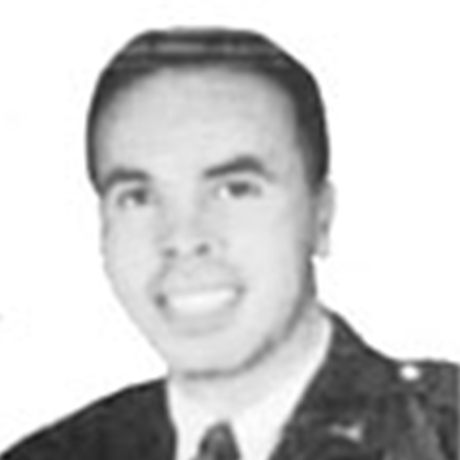
Second Lieutenant
Rudolph B. Davila
1944: World War II
READ MORERudolph B. Davila
 1944: World War II
1944: World War II
Second Lt. Rudolph B. Davila served in Company H, 7th Infantry Regiment, 3rd Infantry Division. He was posthumously awarded the Distinguished Service Cross that was upgraded to the Medal of Honor in 1998 for actions near Artena, Italy, May 28, 1944. Citation: Staff Sergeant Rudolph B. Davila distinguished himself by extraordinary heroism in action, on 28 May 1944, near Artena, Italy. During the offensive which broke through the German mountain strongholds surrounding the Anzio beachhead, Staff Sergeant Davila risked death to provide heavy weapons support for a beleaguered rifle company. Caught on an exposed hillside by heavy, grazing fire from a well-entrenched German force, his machine gunners were reluctant to risk putting their guns into action. Crawling fifty yards to the nearest machine gun, Staff Sergeant Davila set it up alone and opened fire on the enemy. In order to observe the effect of his fire, Sergeant Davila fired from the kneeling position, ignoring the enemy fire that struck the tripod and passed between his legs. Ordering a gunner to take over, he crawled forward to a vantage point and directed the firefight with hand and arm signals until both hostile machine guns were silenced. Bringing his three remaining machine guns into action, he drove the enemy to a reserve position two hundred yards to the rear. When he received a painful wound in the leg, he dashed to a burned tank and, despite the crash of bullets on the hull, engaged a second enemy force from the tank's turret. Dismounting, he advanced 130 yards in short rushes, crawled 20 yards and charged into an enemy-held house to eliminate the defending force of five with a hand grenade and rifle fire. Climbing to the attic, he straddled a large shell hole in the wall and opened fire on the enemy. Although the walls of the house were crumbling, he continued to fire until he had destroyed two more machine guns. His intrepid actions brought desperately needed heavy weapons support to a hard-pressed rifle company and silenced four machine gunners, which forced the enemy to abandon their prepared positions. Staff Sergeant Davila's extraordinary heroism and devotion to duty are in keeping with the highest traditions of military service and reflect great credit on him, his unit, and the United States Army.
Related Articles
Congressional Medal of Honor Society
Second Lieutenant Rudolph B. Davila
1944: World War II
Second Lt. Rudolph B. Davila served in Company H, 7th Infantry Regiment, 3rd Infantry Division. He was posthumously awarded the Distinguished Service Cross that was upgraded to the Medal of Honor in 1998 for actions near Artena, Italy, May 28, 1944. Citation: Staff Sergeant Rudolph B. Davila distinguished himself by extraordinary heroism in action, on 28 May 1944, near Artena, Italy. During the offensive which broke through the German mountain strongholds surrounding the Anzio beachhead, Staff Sergeant Davila risked death to provide heavy weapons support for a beleaguered rifle company. Caught on an exposed hillside by heavy, grazing fire from a well-entrenched German force, his machine gunners were reluctant to risk putting their guns into action. Crawling fifty yards to the nearest machine gun, Staff Sergeant Davila set it up alone and opened fire on the enemy. In order to observe the effect of his fire, Sergeant Davila fired from the kneeling position, ignoring the enemy fire that struck the tripod and passed between his legs. Ordering a gunner to take over, he crawled forward to a vantage point and directed the firefight with hand and arm signals until both hostile machine guns were silenced. Bringing his three remaining machine guns into action, he drove the enemy to a reserve position two hundred yards to the rear. When he received a painful wound in the leg, he dashed to a burned tank and, despite the crash of bullets on the hull, engaged a second enemy force from the tank's turret. Dismounting, he advanced 130 yards in short rushes, crawled 20 yards and charged into an enemy-held house to eliminate the defending force of five with a hand grenade and rifle fire. Climbing to the attic, he straddled a large shell hole in the wall and opened fire on the enemy. Although the walls of the house were crumbling, he continued to fire until he had destroyed two more machine guns. His intrepid actions brought desperately needed heavy weapons support to a hard-pressed rifle company and silenced four machine gunners, which forced the enemy to abandon their prepared positions. Staff Sergeant Davila's extraordinary heroism and devotion to duty are in keeping with the highest traditions of military service and reflect great credit on him, his unit, and the United States Army.
Related Articles
Congressional Medal of Honor Society
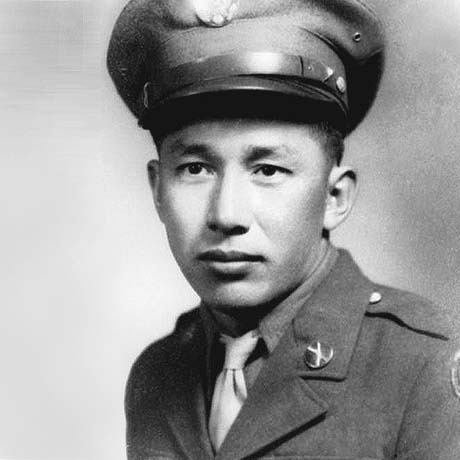
Private
Barney F. Hajiro
1944: World War II
READ MOREBarney F. Hajiro
 1944: World War II
1944: World War II
Pvt. Barney F. Hajiro served in the 442nd Regimental Combat Team. He was posthumously awarded the Distinguished Service Cross that was upgraded to the Medal of Honor in 2000 for actions in the vicinity of Bruyeres and Biffontaine, eastern France, Oct. 19, 22, and 29, 1944. Citation:Private Barney F. Hajiro distinguished himself by extraordinary heroism in action on 19, 22, and 29 October 1944, in the vicinity of Bruyeres and Biffontaine, eastern France. Private Hajiro, while acting as a sentry on top of an embankment on 19 October 1944, in the vicinity of Bruyeres, France, rendered assistance to allied troops attacking a house 200 yards away by exposing himself to enemy fire and directing fire at an enemy strong point. He assisted the unit on his right by firing his automatic rifle and killing or wounding two enemy snipers. On 22 October 1944, he and one comrade took up an outpost security position about 50 yards to the right front of their platoon, concealed themselves, and ambushed an 18-man, heavily armed, enemy patrol, killing two, wounding one, and taking the remainder as prisoners. On 29 October 1944, in a wooded area in the vicinity of Biffontaine, France, Private Hajiro initiated an attack up the slope of a hill referred to as "Suicide Hill" by running forward approximately 100 yards under fire. He then advanced ahead of his comrades about 10 yards, drawing fire and spotting camouflaged machine gun nests. He fearlessly met fire with fire and single-handedly destroyed two machine gun nests and killed two enemy snipers. As a result of Private Hajiro's heroic actions, the attack was successful. Private Hajiro's extraordinary heroism and devotion to duty are in keeping with the highest traditions of military service and reflect great credit upon him, his unit, and the United States Army.
Related Articles
Congressional Medal of Honor Society
Private Barney F. Hajiro
1944: World War II
Pvt. Barney F. Hajiro served in the 442nd Regimental Combat Team. He was posthumously awarded the Distinguished Service Cross that was upgraded to the Medal of Honor in 2000 for actions in the vicinity of Bruyeres and Biffontaine, eastern France, Oct. 19, 22, and 29, 1944. Citation:Private Barney F. Hajiro distinguished himself by extraordinary heroism in action on 19, 22, and 29 October 1944, in the vicinity of Bruyeres and Biffontaine, eastern France. Private Hajiro, while acting as a sentry on top of an embankment on 19 October 1944, in the vicinity of Bruyeres, France, rendered assistance to allied troops attacking a house 200 yards away by exposing himself to enemy fire and directing fire at an enemy strong point. He assisted the unit on his right by firing his automatic rifle and killing or wounding two enemy snipers. On 22 October 1944, he and one comrade took up an outpost security position about 50 yards to the right front of their platoon, concealed themselves, and ambushed an 18-man, heavily armed, enemy patrol, killing two, wounding one, and taking the remainder as prisoners. On 29 October 1944, in a wooded area in the vicinity of Biffontaine, France, Private Hajiro initiated an attack up the slope of a hill referred to as "Suicide Hill" by running forward approximately 100 yards under fire. He then advanced ahead of his comrades about 10 yards, drawing fire and spotting camouflaged machine gun nests. He fearlessly met fire with fire and single-handedly destroyed two machine gun nests and killed two enemy snipers. As a result of Private Hajiro's heroic actions, the attack was successful. Private Hajiro's extraordinary heroism and devotion to duty are in keeping with the highest traditions of military service and reflect great credit upon him, his unit, and the United States Army.
Related Articles
Congressional Medal of Honor Society
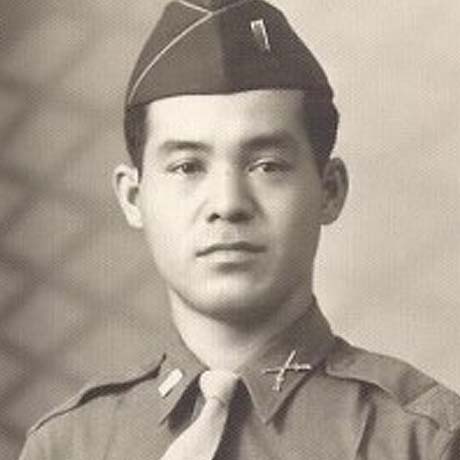
Technical Sergeant
Yeiki Kobashigawa
1944: World War II
READ MOREYeiki Kobashigawa
 1944: World War II
1944: World War II
Tech. Sgt. Yeiki Kobashigawa served in the 100th battalion. He was posthumously awarded the Distinguished Service Cross that was upgraded to the Medal of Honor in the vicinity of Lanuvio, Italy, June 2, 1944. Citation: Technical Sergeant Yeiki Kobashigawa distinguished himself by extraordinary heroism in action on 2 June 1944, in the vicinity of Lanuvio, Italy. During an attack, Technical Sergeant Kobashigawa's platoon encountered strong enemy resistance from a series of machine guns providing supporting fire. Observing a machine gun nest 50 yards from his position, Technical Sergeant Kobashigawa crawled forward with one of his men, threw a grenade and then charged the enemy with his submachine gun while a fellow soldier provided covering fire. He killed one enemy soldier and captured two prisoners. Meanwhile, Technical Sergeant Kobashigawa and his comrade were fired upon by another machine gun 50 yards ahead. Directing a squad to advance to his first position, Technical Sergeant Kobashigawa again moved forward with a fellow soldier to subdue the second machine gun nest. After throwing grenades into the position, Technical Sergeant Kobashigawa provided close supporting fire while a fellow soldier charged, capturing four prisoners. On the alert for other machine gun nests, Technical Sergeant Kobashigawa discovered four more, and skillfully led a squad in neutralizing two of them. Technical Sergeant Kobashigawa's extraordinary heroism and devotion to duty are in keeping with the highest traditions of military service and reflect great credit on him, his unit, and the United States Army.
Related Articles
Congressional Medal of Honor Society
Technical Sergeant Yeiki Kobashigawa
1944: World War II
Tech. Sgt. Yeiki Kobashigawa served in the 100th battalion. He was posthumously awarded the Distinguished Service Cross that was upgraded to the Medal of Honor in the vicinity of Lanuvio, Italy, June 2, 1944. Citation: Technical Sergeant Yeiki Kobashigawa distinguished himself by extraordinary heroism in action on 2 June 1944, in the vicinity of Lanuvio, Italy. During an attack, Technical Sergeant Kobashigawa's platoon encountered strong enemy resistance from a series of machine guns providing supporting fire. Observing a machine gun nest 50 yards from his position, Technical Sergeant Kobashigawa crawled forward with one of his men, threw a grenade and then charged the enemy with his submachine gun while a fellow soldier provided covering fire. He killed one enemy soldier and captured two prisoners. Meanwhile, Technical Sergeant Kobashigawa and his comrade were fired upon by another machine gun 50 yards ahead. Directing a squad to advance to his first position, Technical Sergeant Kobashigawa again moved forward with a fellow soldier to subdue the second machine gun nest. After throwing grenades into the position, Technical Sergeant Kobashigawa provided close supporting fire while a fellow soldier charged, capturing four prisoners. On the alert for other machine gun nests, Technical Sergeant Kobashigawa discovered four more, and skillfully led a squad in neutralizing two of them. Technical Sergeant Kobashigawa's extraordinary heroism and devotion to duty are in keeping with the highest traditions of military service and reflect great credit on him, his unit, and the United States Army.
Related Articles
Congressional Medal of Honor Society
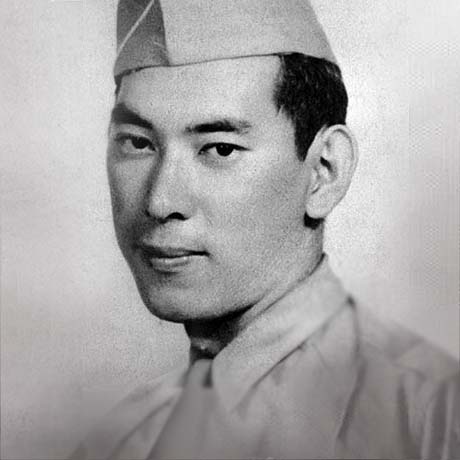
Staff Sergeant
Robert T. Kuroda
1944: World War II
READ MORERobert T. Kuroda
 1944: World War II
1944: World War II
Staff Sgt. Robert T. Kuroda served in the 442nd Regimental Combat Team. He was posthumously awarded the Distinguished Service Cross that was upgraded to the Medal of Honor for his actions near Bruyeres, France, Oct. 20, 1944. Citation: Staff Sergeant Robert T. Kuroda distinguished himself by extraordinary heroism in action, on 20 October 1944, near Bruyeres, France. Leading his men in an advance to destroy snipers and machine gun nests, Staff Sergeant Kuroda encountered heavy fire from enemy soldiers occupying a heavily wooded slope. Unable to pinpoint the hostile machine gun, he boldly made his way through heavy fire to the crest of the ridge. Once he located the machine gun, Staff Sergeant Kuroda advanced to a point within ten yards of the nest and killed three enemy gunners with grenades. He then fired clip after clip of rifle ammunition, killing or wounding at least three of the enemy. As he expended the last of his ammunition, he observed that an American officer had been struck by a burst of fire from a hostile machine gun located on an adjacent hill. Rushing to the officer's assistance, he found that the officer had been killed. Picking up the officer's submachine gun, Staff Sergeant Kuroda advanced through continuous fire toward a second machine gun emplacement and destroyed the position. As he turned to fire upon additional enemy soldiers, he was killed by a sniper. Staff Sergeant Kuroda's courageous actions and indomitable fighting spirit ensured the destruction of enemy resistance in the sector. Staff Sergeant Kuroda's extraordinary heroism and devotion to duty are in keeping with the highest traditions of military service and reflect great credit on him, his unit, and the United States Army.
Related Articles
Congressional Medal of Honor Society.
Army.mil: New Army Vessel Named after Medal of Honor Recipient Arrives in Hawaii
Staff Sergeant Robert T. Kuroda
1944: World War II
Staff Sgt. Robert T. Kuroda served in the 442nd Regimental Combat Team. He was posthumously awarded the Distinguished Service Cross that was upgraded to the Medal of Honor for his actions near Bruyeres, France, Oct. 20, 1944. Citation: Staff Sergeant Robert T. Kuroda distinguished himself by extraordinary heroism in action, on 20 October 1944, near Bruyeres, France. Leading his men in an advance to destroy snipers and machine gun nests, Staff Sergeant Kuroda encountered heavy fire from enemy soldiers occupying a heavily wooded slope. Unable to pinpoint the hostile machine gun, he boldly made his way through heavy fire to the crest of the ridge. Once he located the machine gun, Staff Sergeant Kuroda advanced to a point within ten yards of the nest and killed three enemy gunners with grenades. He then fired clip after clip of rifle ammunition, killing or wounding at least three of the enemy. As he expended the last of his ammunition, he observed that an American officer had been struck by a burst of fire from a hostile machine gun located on an adjacent hill. Rushing to the officer's assistance, he found that the officer had been killed. Picking up the officer's submachine gun, Staff Sergeant Kuroda advanced through continuous fire toward a second machine gun emplacement and destroyed the position. As he turned to fire upon additional enemy soldiers, he was killed by a sniper. Staff Sergeant Kuroda's courageous actions and indomitable fighting spirit ensured the destruction of enemy resistance in the sector. Staff Sergeant Kuroda's extraordinary heroism and devotion to duty are in keeping with the highest traditions of military service and reflect great credit on him, his unit, and the United States Army.
Related Articles
Congressional Medal of Honor Society.
Army.mil: New Army Vessel Named after Medal of Honor Recipient Arrives in Hawaii
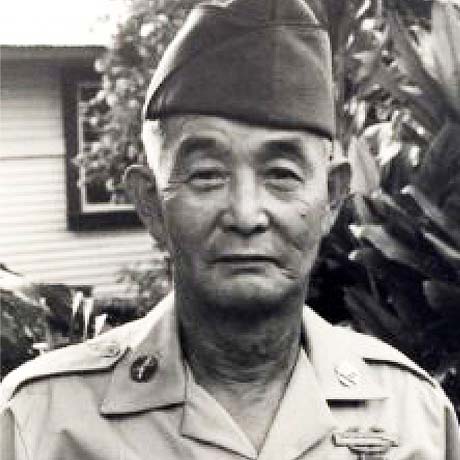
Private First Class
Kaora Moto
1944: World War II
READ MOREKaora Moto
 1944: World War II
1944: World War II
Pfc. Kaoru Moto served in the 100th Infantry Battalion. He was posthumously awarded the Distinguished Service Cross that was upgraded to the Medal of Honor for his actions near Castellina, Italy, July 7, 1944. Citation: Private First Class Kaoru Moto distinguished himself by extraordinary heroism in action on 7 July 1944, near Castellina, Italy. While serving as first scout, Private First Class Moto observed a machine gun nest that was hindering his platoon's progress. On his own initiative, he made his way to a point ten paces from the hostile position, and killed the enemy machine gunner. Immediately, the enemy assistant gunner opened fire in the direction of Private First Class Moto. Crawling to the rear of the position, Private First Class Moto surprised the enemy soldier, who quickly surrendered. Taking his prisoner with him, Private First Class Moto took a position a few yards from a house to prevent the enemy from using the building as an observation post. While guarding the house and his prisoner, he observed an enemy machine gun team moving into position. He engaged them, and with deadly fire forced the enemy to withdraw. An enemy sniper located in another house fired at Private First Class Moto, severely wounding him. Applying first aid to his wound, he changed position to elude the sniper fire and to advance. Finally relieved of his position, he made his way to the rear for treatment. Crossing a road, he spotted an enemy machine gun nest. Opening fire, he wounded two of the three soldiers occupying the position. Not satisfied with this accomplishment, he then crawled forward to a better position and ordered the enemy soldier to surrender. Receiving no answer, Private First Class Moto fired at the position, and the soldiers surrendered. Private First Class Moto's extraordinary heroism and devotion to duty are in keeping with the highest traditions of military service and reflect great credit on him, his unit, and the United States Army.
Related Articles
Congressional Medal of Honor Society
Private First Class Kaora Moto
1944: World War II
Pfc. Kaoru Moto served in the 100th Infantry Battalion. He was posthumously awarded the Distinguished Service Cross that was upgraded to the Medal of Honor for his actions near Castellina, Italy, July 7, 1944. Citation: Private First Class Kaoru Moto distinguished himself by extraordinary heroism in action on 7 July 1944, near Castellina, Italy. While serving as first scout, Private First Class Moto observed a machine gun nest that was hindering his platoon's progress. On his own initiative, he made his way to a point ten paces from the hostile position, and killed the enemy machine gunner. Immediately, the enemy assistant gunner opened fire in the direction of Private First Class Moto. Crawling to the rear of the position, Private First Class Moto surprised the enemy soldier, who quickly surrendered. Taking his prisoner with him, Private First Class Moto took a position a few yards from a house to prevent the enemy from using the building as an observation post. While guarding the house and his prisoner, he observed an enemy machine gun team moving into position. He engaged them, and with deadly fire forced the enemy to withdraw. An enemy sniper located in another house fired at Private First Class Moto, severely wounding him. Applying first aid to his wound, he changed position to elude the sniper fire and to advance. Finally relieved of his position, he made his way to the rear for treatment. Crossing a road, he spotted an enemy machine gun nest. Opening fire, he wounded two of the three soldiers occupying the position. Not satisfied with this accomplishment, he then crawled forward to a better position and ordered the enemy soldier to surrender. Receiving no answer, Private First Class Moto fired at the position, and the soldiers surrendered. Private First Class Moto's extraordinary heroism and devotion to duty are in keeping with the highest traditions of military service and reflect great credit on him, his unit, and the United States Army.
Related Articles
Congressional Medal of Honor Society
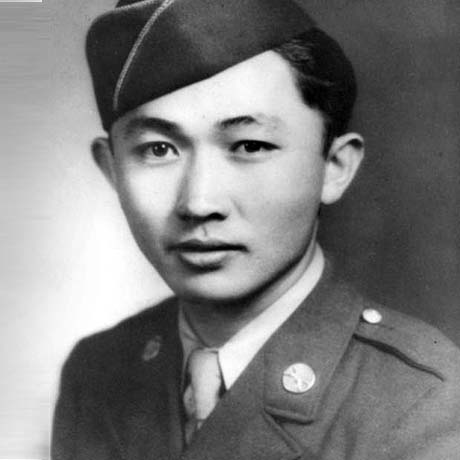
Private First Class
Kiyoshi K. Muranaga
1944: World War II
READ MOREKiyoshi K. Muranaga
 1944: World War II
1944: World War II
Pfc. Kiyoshi K. Muranaga served in the 442nd Regimental Combat Team. He was posthumously awarded the Distinguished Service Cross that was upgraded to the Medal of Honor in 2000 for actions near Suvereto, Italy, June 26, 1944. Citation: Private First Class Kiyoshi K. Muranaga, a Medal of Honor recipient, distinguished himself by extraordinary heroism in action on June 26, 1944, near Suvereto, Italy. Private First Class Muranaga's company encountered a strong enemy force in commanding positions and with superior firepower. An enemy 88mm self-propelled gun opened direct fire on the company, causing the men to disperse and seek cover. Private First Class Muranaga's mortar squad was ordered to action, but the terrain made it impossible to set up their weapons. The squad leader, realizing the vulnerability of the mortar position, moved his men away from the gun to positions of relative safety. Because of the heavy casualties being inflicted on his company, Private First Class Muranaga, who served as a gunner, attempted to neutralize the 88mm weapon alone. Voluntarily remaining at his gun position, Private First Class Muranaga manned the mortar himself and opened fire on the enemy gun at a range of approximately 400 yards. With his third round, he was able to correct his fire so that the shell landed directly in front of the enemy gun. Meanwhile, the enemy crew, immediately aware of the source of mortar fire, turned their 88mm weapon directly on Private First Class Muranaga's position. Before Private First Class Muranaga could fire a fourth round, an 88mm shell scored a direct hit on his position, killing him instantly. Because of the accuracy of Private First Class Muranaga's previous fire, the enemy soldiers decided not to risk further exposure and immediately abandoned their position. Private First Class Muranaga's extraordinary heroism and devotion to duty are in keeping with the highest traditions of military service and reflect great credit on him, his unit, and the United States Army.
Related Articles
Congressional Medal of Honor Society
Private First Class Kiyoshi K. Muranaga
1944: World War II
Pfc. Kiyoshi K. Muranaga served in the 442nd Regimental Combat Team. He was posthumously awarded the Distinguished Service Cross that was upgraded to the Medal of Honor in 2000 for actions near Suvereto, Italy, June 26, 1944. Citation: Private First Class Kiyoshi K. Muranaga, a Medal of Honor recipient, distinguished himself by extraordinary heroism in action on June 26, 1944, near Suvereto, Italy. Private First Class Muranaga's company encountered a strong enemy force in commanding positions and with superior firepower. An enemy 88mm self-propelled gun opened direct fire on the company, causing the men to disperse and seek cover. Private First Class Muranaga's mortar squad was ordered to action, but the terrain made it impossible to set up their weapons. The squad leader, realizing the vulnerability of the mortar position, moved his men away from the gun to positions of relative safety. Because of the heavy casualties being inflicted on his company, Private First Class Muranaga, who served as a gunner, attempted to neutralize the 88mm weapon alone. Voluntarily remaining at his gun position, Private First Class Muranaga manned the mortar himself and opened fire on the enemy gun at a range of approximately 400 yards. With his third round, he was able to correct his fire so that the shell landed directly in front of the enemy gun. Meanwhile, the enemy crew, immediately aware of the source of mortar fire, turned their 88mm weapon directly on Private First Class Muranaga's position. Before Private First Class Muranaga could fire a fourth round, an 88mm shell scored a direct hit on his position, killing him instantly. Because of the accuracy of Private First Class Muranaga's previous fire, the enemy soldiers decided not to risk further exposure and immediately abandoned their position. Private First Class Muranaga's extraordinary heroism and devotion to duty are in keeping with the highest traditions of military service and reflect great credit on him, his unit, and the United States Army.
Related Articles
Congressional Medal of Honor Society
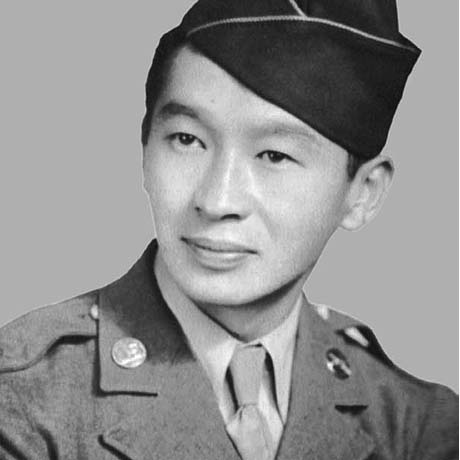
Private First Class
Masato Nakae
1944: World War II
READ MOREMasato Nakae
 1944: World War II
1944: World War II
Pvt. Masato Nakae served in the 100th Infantry Battalion. He was posthumously awarded the Distinguished Service Cross that was upgraded to the Medal of Honor for his actions near Pisa, Italy, Aug. 19, 1944. Citation: Private Masato Nakae distinguished himself by extraordinary heroism in action on 19 August 1944, near Pisa, Italy. When his submachine gun was damaged by a shell fragment during a fierce attack by a superior enemy force, Private Nakae quickly picked up his wounded comrade's M-1 rifle and fired rifle grenades at the steadily advancing enemy. As the hostile force continued to close in on his position, Private Nakae threw six grenades and forced them to withdraw. During a concentrated enemy mortar barrage that preceded the next assault by the enemy force, a mortar shell fragment seriously wounded Private Nakae. Despite his injury, he refused to surrender his position and continued firing at the advancing enemy. By inflicting heavy casualties on the enemy force, he finally succeeded in breaking up the attack and caused the enemy to withdraw. Private Nakae's extraordinary heroism and devotion to duty are in keeping with the highest traditions of military service and reflect great credit on him, his unit, and the United States Army.
Related Articles
Congressional Medal of Honor Society
Private First Class Masato Nakae
1944: World War II
Pvt. Masato Nakae served in the 100th Infantry Battalion. He was posthumously awarded the Distinguished Service Cross that was upgraded to the Medal of Honor for his actions near Pisa, Italy, Aug. 19, 1944. Citation: Private Masato Nakae distinguished himself by extraordinary heroism in action on 19 August 1944, near Pisa, Italy. When his submachine gun was damaged by a shell fragment during a fierce attack by a superior enemy force, Private Nakae quickly picked up his wounded comrade's M-1 rifle and fired rifle grenades at the steadily advancing enemy. As the hostile force continued to close in on his position, Private Nakae threw six grenades and forced them to withdraw. During a concentrated enemy mortar barrage that preceded the next assault by the enemy force, a mortar shell fragment seriously wounded Private Nakae. Despite his injury, he refused to surrender his position and continued firing at the advancing enemy. By inflicting heavy casualties on the enemy force, he finally succeeded in breaking up the attack and caused the enemy to withdraw. Private Nakae's extraordinary heroism and devotion to duty are in keeping with the highest traditions of military service and reflect great credit on him, his unit, and the United States Army.
Related Articles
Congressional Medal of Honor Society
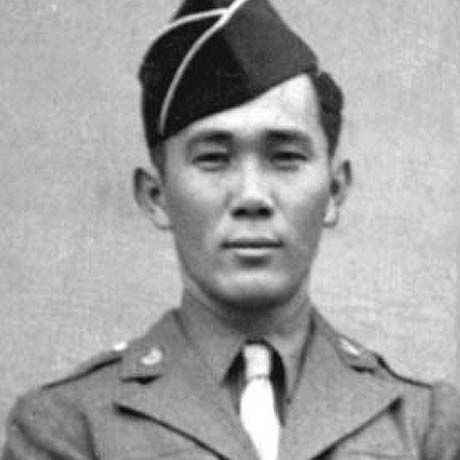
Private
Shinyei Nakamine
1944: World War II
READ MOREShinyei Nakamine
 1944: World War II
1944: World War II
Pvt. Shinyei Nakamine served in the 100th Infantry Battalion. He was posthumously awarded the Distinguished Service Cross that was upgraded to the Medal of Honor in 2000 for actions near La Torreto, Italy, June 2, 1944. Citation: Private Shinyei Nakamine distinguished himself by extraordinary heroism in action on 2 June 1944, near La Torreto, Italy. During an attack, Private Nakamine's platoon became pinned down by intense machine gun crossfire from a small knoll 200 yards to the front. On his own initiative, Private Nakamine crawled toward one of the hostile weapons. Reaching a point 25 yards from the enemy, he charged the machine gun nest, firing his submachine gun, and killed three enemy soldiers and captured two. Later that afternoon, Private Nakamine discovered an enemy soldier on the right flank of his platoon's position. Crawling 25 yards from his position, Private Nakamine opened fire and killed the soldier. Then, seeing a machine gun nest to his front approximately 75 yards away, he returned to his platoon and led an automatic rifle team toward the enemy. Under covering fire from his team, Private Nakamine crawled to a point 25 yards from the nest and threw hand grenades at the enemy soldiers, wounding one and capturing four. Spotting another machine gun nest 100 yards to his right flank, he led the automatic rifle team toward the hostile position but was killed by a burst of machine gun fire. Private Nakamine's extraordinary heroism and devotion to duty are in keeping with the highest traditions of military service and reflect great credit on him, his unit, and the United States Army.
Related Articles
Congressional Medal of Honor Society
Private Shinyei Nakamine
1944: World War II
Pvt. Shinyei Nakamine served in the 100th Infantry Battalion. He was posthumously awarded the Distinguished Service Cross that was upgraded to the Medal of Honor in 2000 for actions near La Torreto, Italy, June 2, 1944. Citation: Private Shinyei Nakamine distinguished himself by extraordinary heroism in action on 2 June 1944, near La Torreto, Italy. During an attack, Private Nakamine's platoon became pinned down by intense machine gun crossfire from a small knoll 200 yards to the front. On his own initiative, Private Nakamine crawled toward one of the hostile weapons. Reaching a point 25 yards from the enemy, he charged the machine gun nest, firing his submachine gun, and killed three enemy soldiers and captured two. Later that afternoon, Private Nakamine discovered an enemy soldier on the right flank of his platoon's position. Crawling 25 yards from his position, Private Nakamine opened fire and killed the soldier. Then, seeing a machine gun nest to his front approximately 75 yards away, he returned to his platoon and led an automatic rifle team toward the enemy. Under covering fire from his team, Private Nakamine crawled to a point 25 yards from the nest and threw hand grenades at the enemy soldiers, wounding one and capturing four. Spotting another machine gun nest 100 yards to his right flank, he led the automatic rifle team toward the hostile position but was killed by a burst of machine gun fire. Private Nakamine's extraordinary heroism and devotion to duty are in keeping with the highest traditions of military service and reflect great credit on him, his unit, and the United States Army.
Related Articles
Congressional Medal of Honor Society
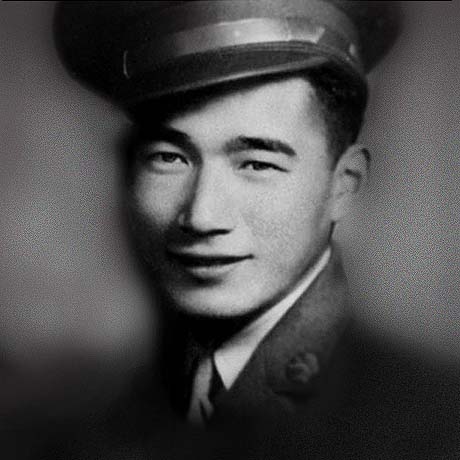
Private First Class
William K. Nakamura
1944: World War II
READ MOREWilliam K. Nakamura
 1944: World War II
1944: World War II
Pfc. William K. Nakamura served in the 100th Infantry Battalion. He was posthumously awarded the Distinguished Service Cross that was upgraded to the Medal of Honor for actions near Castellina, Italy, July 4, 1944.Citation: Private First Class William K. Nakamura distinguished himself by extraordinary heroism in action on 4 July 1944, near Castellina, Italy. During a fierce firefight, Private First Class Nakamura's platoon became pinned down by enemy machine gun fire from a concealed position. On his own initiative, Private First Class Nakamura crawled 20 yards toward the hostile nest with fire from the enemy machine gun barely missing him. Reaching a point 15 yards from the position, he quickly raised himself to a kneeling position and threw four hand grenades, killing or wounding at least three of the enemy soldiers. The enemy weapon silenced, Private First Class Nakamura crawled back to his platoon, which was able to continue its advance as a result of his courageous action. Later, his company was ordered to withdraw from the crest of a hill so that a mortar barrage could be placed on the ridge. On his own initiative, Private First Class Nakamura remained in position to cover his comrades' withdrawal. While moving toward the safety of a wooded draw, his platoon became pinned down by deadly machine gun fire. Crawling to a point from which he could fire on the enemy position, Private First Class Nakamura quickly and accurately fired his weapon to pin down the enemy machine gunners. His platoon was then able to withdraw to safety without further casualties. Private First Class Nakamura was killed during this heroic stand. Private First Class Nakamura's extraordinary heroism and devotion to duty are in keeping with the highest traditions of military service and reflect great credit on him, his unit, and the United States Army.
Related Articles
Congressional Medal of Honor Society
Private First Class William K. Nakamura
1944: World War II
Pfc. William K. Nakamura served in the 100th Infantry Battalion. He was posthumously awarded the Distinguished Service Cross that was upgraded to the Medal of Honor for actions near Castellina, Italy, July 4, 1944.Citation: Private First Class William K. Nakamura distinguished himself by extraordinary heroism in action on 4 July 1944, near Castellina, Italy. During a fierce firefight, Private First Class Nakamura's platoon became pinned down by enemy machine gun fire from a concealed position. On his own initiative, Private First Class Nakamura crawled 20 yards toward the hostile nest with fire from the enemy machine gun barely missing him. Reaching a point 15 yards from the position, he quickly raised himself to a kneeling position and threw four hand grenades, killing or wounding at least three of the enemy soldiers. The enemy weapon silenced, Private First Class Nakamura crawled back to his platoon, which was able to continue its advance as a result of his courageous action. Later, his company was ordered to withdraw from the crest of a hill so that a mortar barrage could be placed on the ridge. On his own initiative, Private First Class Nakamura remained in position to cover his comrades' withdrawal. While moving toward the safety of a wooded draw, his platoon became pinned down by deadly machine gun fire. Crawling to a point from which he could fire on the enemy position, Private First Class Nakamura quickly and accurately fired his weapon to pin down the enemy machine gunners. His platoon was then able to withdraw to safety without further casualties. Private First Class Nakamura was killed during this heroic stand. Private First Class Nakamura's extraordinary heroism and devotion to duty are in keeping with the highest traditions of military service and reflect great credit on him, his unit, and the United States Army.
Related Articles
Congressional Medal of Honor Society
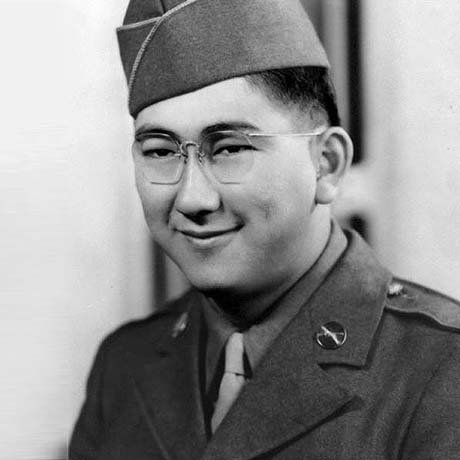
Private First Class
Joe M. Nishimoto
1944: World War II
READ MOREJoe M. Nishimoto
 1944: World War II
1944: World War II
Pfc. Joe M. Nishimoto served in the 442nd Regimental Combat. He was posthumously awarded the Distinguished Service Cross that was upgraded to the Medal of Honor for actions near La Houssiere, France, Nov. 7, 1944. Citation: Private First Class Joe M. Nishimoto distinguished himself by extraordinary heroism in action on 7 November 1944, near La Houssiere, France. After three days of unsuccessful attempts by his company to dislodge the enemy from a strongly defended ridge, Private First Class Nishimoto, as acting squad leader, boldly crawled forward through a heavily mined and booby-trapped area. Spotting a machine gun nest, he hurled a grenade and destroyed the emplacement. Then, circling to the rear of another machine gun position, he fired his submachine gun at point-blank range, killing one gunner and wounding another. Pursuing two enemy riflemen, Private First Class Nishimoto killed one, while the other hastily retreated. Continuing his determined assault, he drove another machine gun crew from its position. The enemy, with their key strong points taken, were forced to withdraw from this sector. Private First Class Nishimoto's extraordinary heroism and devotion to duty are in keeping with the highest traditions of military service and reflect great credit on him, his unit, and the United States Army.
Related Articles
Congressional Medal of Honor Society
Private First Class Joe M. Nishimoto
1944: World War II
Pfc. Joe M. Nishimoto served in the 442nd Regimental Combat. He was posthumously awarded the Distinguished Service Cross that was upgraded to the Medal of Honor for actions near La Houssiere, France, Nov. 7, 1944. Citation: Private First Class Joe M. Nishimoto distinguished himself by extraordinary heroism in action on 7 November 1944, near La Houssiere, France. After three days of unsuccessful attempts by his company to dislodge the enemy from a strongly defended ridge, Private First Class Nishimoto, as acting squad leader, boldly crawled forward through a heavily mined and booby-trapped area. Spotting a machine gun nest, he hurled a grenade and destroyed the emplacement. Then, circling to the rear of another machine gun position, he fired his submachine gun at point-blank range, killing one gunner and wounding another. Pursuing two enemy riflemen, Private First Class Nishimoto killed one, while the other hastily retreated. Continuing his determined assault, he drove another machine gun crew from its position. The enemy, with their key strong points taken, were forced to withdraw from this sector. Private First Class Nishimoto's extraordinary heroism and devotion to duty are in keeping with the highest traditions of military service and reflect great credit on him, his unit, and the United States Army.
Related Articles
Congressional Medal of Honor Society
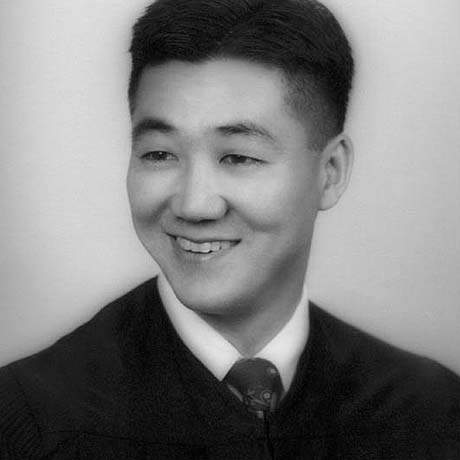
Technician Fifth Grade
James K. Okubo
1944: World War II
READ MOREJames K. Okubo
 1944: World War II
1944: World War II
Technician Fifth Grade James K. Okubo served in the 442nd Regimental Combat Team. He was posthumously awarded the Distinguished Service Cross that was upgraded to the Medal of Honor for his actions in Foret Domaniale de Champ, near Biffontaine, eastern France, Oct 28-29 and Nov. 4, 1944. Citation: Technician Fifth Grade James K. Okubo distinguished himself by extraordinary heroism in action on 28 and 29 October and 4 November 1944, in the Foret Domaniale de Champ, near Biffontaine, eastern France. On 28 October, under strong enemy fire coming from behind mine fields and roadblocks, Technician Fifth Grade Okubo, a medic, crawled 150 yards to within 40 yards of the enemy lines. Two grenades were thrown at him while he left his last covered position to carry back wounded comrades. Under constant barrages of enemy small arms and machine gun fire, he treated 17 men on 28 October and 8 more men on 29 October. On 4 November, Technician Fifth Grade Okubo ran 75 yards under grazing machine gun fire and, while exposed to hostile fire directed at him, evacuated and treated a seriously wounded crewman from a burning tank, who otherwise would have died. Technician Fifth Grade James K. Okubo's extraordinary heroism and devotion to duty are in keeping with the highest traditions of military service and reflect great credit on him, his unit, and the United States Army.
Related Articles
Congressional Medal of Honor Society
Technician Fifth Grade James K. Okubo
1944: World War II
Technician Fifth Grade James K. Okubo served in the 442nd Regimental Combat Team. He was posthumously awarded the Distinguished Service Cross that was upgraded to the Medal of Honor for his actions in Foret Domaniale de Champ, near Biffontaine, eastern France, Oct 28-29 and Nov. 4, 1944. Citation: Technician Fifth Grade James K. Okubo distinguished himself by extraordinary heroism in action on 28 and 29 October and 4 November 1944, in the Foret Domaniale de Champ, near Biffontaine, eastern France. On 28 October, under strong enemy fire coming from behind mine fields and roadblocks, Technician Fifth Grade Okubo, a medic, crawled 150 yards to within 40 yards of the enemy lines. Two grenades were thrown at him while he left his last covered position to carry back wounded comrades. Under constant barrages of enemy small arms and machine gun fire, he treated 17 men on 28 October and 8 more men on 29 October. On 4 November, Technician Fifth Grade Okubo ran 75 yards under grazing machine gun fire and, while exposed to hostile fire directed at him, evacuated and treated a seriously wounded crewman from a burning tank, who otherwise would have died. Technician Fifth Grade James K. Okubo's extraordinary heroism and devotion to duty are in keeping with the highest traditions of military service and reflect great credit on him, his unit, and the United States Army.
Related Articles
Congressional Medal of Honor Society
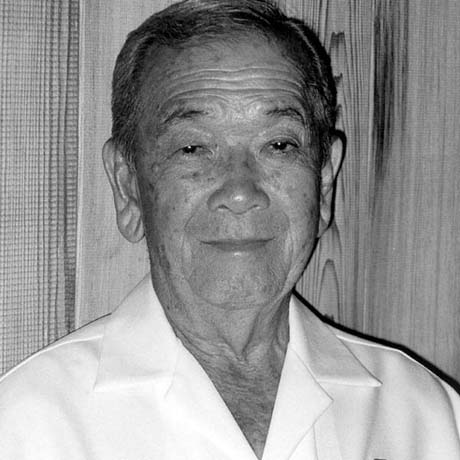
Technical Sergeant
Yukio Okutsu
1945: World War II
READ MOREYukio Okutsu
 1945: World War II
1945: World War II
Tech. Sgt. Yukio Okutsu served in the 442nd Regimental Combat Team. He was posthumously awarded the Distinguished Service Cross that was upgraded to the Medal of Honor on Mount Belvedere, Italy, April 7, 1945. Citation: Technical Sergeant Yukio Okutsu distinguished himself by extraordinary heroism in action on 7 April 1945, on Mount Belvedere, Italy. While his platoon was halted by the crossfire of three machine guns, Technical Sergeant Okutsu boldly crawled to within 30 yards of the nearest enemy emplacement through heavy fire. He destroyed the position with two accurately placed hand grenades, killing three machine gunners. Crawling and dashing from cover to cover, he threw another grenade, silencing a second machine gun, wounding two enemy soldiers, and forcing two others to surrender. Seeing a third machine gun, which obstructed his platoon's advance, he moved forward through heavy small arms fire and was stunned momentarily by rifle fire, which glanced off his helmet. Recovering, he bravely charged several enemy riflemen with his submachine gun, forcing them to withdraw from their positions. Then, rushing the machine gun nest, he captured the weapon and its entire crew of four. By these single-handed actions he enabled his platoon to resume its assault on a vital objective. The courageous performance of Technical Sergeant Okutsu against formidable odds was an inspiration to all. Technical Sergeant Okutsu's extraordinary heroism and devotion to duty are in keeping with the highest traditions of military service and reflect great credit on him, his unit, and the United States Army.
Related Articles
Congressional Medal of Honor Society
Technical Sergeant Yukio Okutsu
1945: World War II
Tech. Sgt. Yukio Okutsu served in the 442nd Regimental Combat Team. He was posthumously awarded the Distinguished Service Cross that was upgraded to the Medal of Honor on Mount Belvedere, Italy, April 7, 1945. Citation: Technical Sergeant Yukio Okutsu distinguished himself by extraordinary heroism in action on 7 April 1945, on Mount Belvedere, Italy. While his platoon was halted by the crossfire of three machine guns, Technical Sergeant Okutsu boldly crawled to within 30 yards of the nearest enemy emplacement through heavy fire. He destroyed the position with two accurately placed hand grenades, killing three machine gunners. Crawling and dashing from cover to cover, he threw another grenade, silencing a second machine gun, wounding two enemy soldiers, and forcing two others to surrender. Seeing a third machine gun, which obstructed his platoon's advance, he moved forward through heavy small arms fire and was stunned momentarily by rifle fire, which glanced off his helmet. Recovering, he bravely charged several enemy riflemen with his submachine gun, forcing them to withdraw from their positions. Then, rushing the machine gun nest, he captured the weapon and its entire crew of four. By these single-handed actions he enabled his platoon to resume its assault on a vital objective. The courageous performance of Technical Sergeant Okutsu against formidable odds was an inspiration to all. Technical Sergeant Okutsu's extraordinary heroism and devotion to duty are in keeping with the highest traditions of military service and reflect great credit on him, his unit, and the United States Army.
Related Articles
Congressional Medal of Honor Society
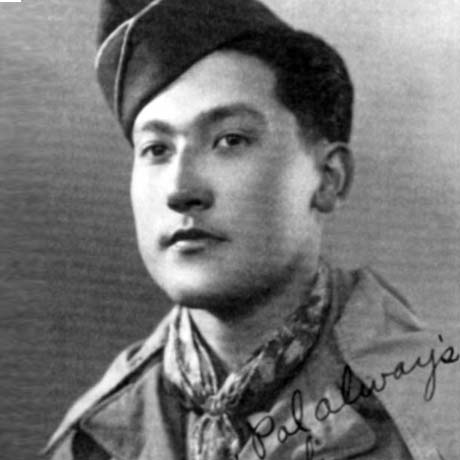
Private First Class
Frank H. Ono
1944: World War II
READ MOREFrank H. Ono
 1944: World War II
1944: World War II
Pfc. Frank H. Ono served in the 442nd Regimental Combat Team. He was posthumously awarded the Distinguished Service Cross that was upgraded to the Medal of Honor for his actions near Castellina, Italy, July 4, 1944. Citation: Private First Class Frank H. Ono distinguished himself by extraordinary heroism in action on 4 July 1944, near Castellina, Italy. In attacking a heavily defended hill, Private First Class Ono's squad was caught in a hail of formidable fire from the well-entrenched enemy. Private First Class Ono opened fire with his automatic rifle and silenced one machine gun 300 hundred yards to the right front. Advancing through incessant fire, he killed a sniper with another burst of fire, and while his squad leader reorganized the rest of the platoon in the rear, he alone defended the critical position. His weapon was then wrenched from his grasp by a burst of enemy machine pistol fire as enemy troops attempted to close in on him. Hurling hand grenades, Private First Class Ono forced the enemy to abandon the attempt, resolutely defending the newly won ground until the rest of the platoon moved forward. Taking a wounded comrade's rifle, Private First Class Ono again joined in the assault. After killing two more enemy soldiers, he boldly ran through withering automatic, small arms, and mortar fire to render first aid to his platoon leader and a seriously wounded rifleman. In danger of being encircled, the platoon was ordered to withdraw. Volunteering to cover the platoon, Private First Class Ono occupied virtually unprotected positions near the crest of the hill, engaging an enemy machine gun emplaced on an adjoining ridge and exchanging fire with snipers armed with machine pistols. Completely disregarding his own safety, he made himself the constant target of concentrated enemy fire until the platoon reached the comparative safety of a draw. He then descended the hill in stages, firing his rifle, until he rejoined the platoon. Private First Class Ono's extraordinary heroism and devotion to duty are in keeping with the highest traditions of military service and reflect great credit on him, his unit, and the United States Army.
Related Articles
Congressional Medal of Honor Society
Private First Class Frank H. Ono
1944: World War II
Pfc. Frank H. Ono served in the 442nd Regimental Combat Team. He was posthumously awarded the Distinguished Service Cross that was upgraded to the Medal of Honor for his actions near Castellina, Italy, July 4, 1944. Citation: Private First Class Frank H. Ono distinguished himself by extraordinary heroism in action on 4 July 1944, near Castellina, Italy. In attacking a heavily defended hill, Private First Class Ono's squad was caught in a hail of formidable fire from the well-entrenched enemy. Private First Class Ono opened fire with his automatic rifle and silenced one machine gun 300 hundred yards to the right front. Advancing through incessant fire, he killed a sniper with another burst of fire, and while his squad leader reorganized the rest of the platoon in the rear, he alone defended the critical position. His weapon was then wrenched from his grasp by a burst of enemy machine pistol fire as enemy troops attempted to close in on him. Hurling hand grenades, Private First Class Ono forced the enemy to abandon the attempt, resolutely defending the newly won ground until the rest of the platoon moved forward. Taking a wounded comrade's rifle, Private First Class Ono again joined in the assault. After killing two more enemy soldiers, he boldly ran through withering automatic, small arms, and mortar fire to render first aid to his platoon leader and a seriously wounded rifleman. In danger of being encircled, the platoon was ordered to withdraw. Volunteering to cover the platoon, Private First Class Ono occupied virtually unprotected positions near the crest of the hill, engaging an enemy machine gun emplaced on an adjoining ridge and exchanging fire with snipers armed with machine pistols. Completely disregarding his own safety, he made himself the constant target of concentrated enemy fire until the platoon reached the comparative safety of a draw. He then descended the hill in stages, firing his rifle, until he rejoined the platoon. Private First Class Ono's extraordinary heroism and devotion to duty are in keeping with the highest traditions of military service and reflect great credit on him, his unit, and the United States Army.
Related Articles
Congressional Medal of Honor Society
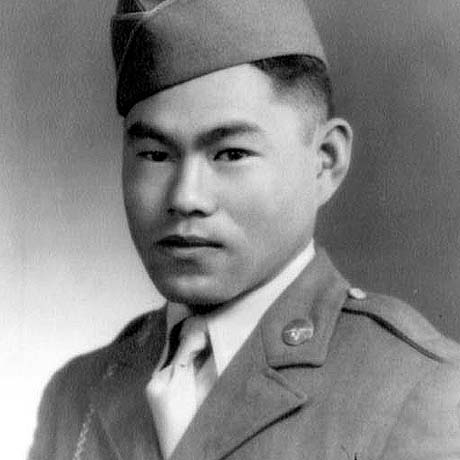
Staff Sergeant
Kazuo Otani
1944: World War II
READ MOREKazuo Otani
 1944: World War II
1944: World War II
Staff Sgt. Kazuo Otani served in the 442nd Regimental Combat Team. He was posthumously awarded the Distinguished Service Cross that was upgraded to the Medal of Honor for his actions near Pieve Di S. Luce, Italy, July 15, 1944.Citation: Staff Sergeant Kazuo Otani distinguished himself by extraordinary heroism in action on 15 July 1944, near Pieve Di S. Luce, Italy. Advancing to attack a hill objective, Staff Sergeant Otani's platoon became pinned down in a wheat field by concentrated fire from enemy machine gun and sniper positions. Realizing the danger confronting his platoon, Staff Sergeant Otani left his cover and shot and killed a sniper who was firing with deadly effect upon the platoon. Followed by a steady stream of machine gun bullets, Staff Sergeant Otani then dashed across the open wheat field toward the foot of a cliff, and directed his men to crawl to the cover of the cliff. When the movement of the platoon drew heavy enemy fire, he dashed along the cliff toward the left flank, exposing himself to enemy fire. By attracting the attention of the enemy, he enabled the men closest to the cliff to reach cover. Organizing these men to guard against possible enemy counterattack, Staff Sergeant Otani again made his way across the open field, shouting instructions to the stranded men while continuing to draw enemy fire. Reaching the rear of the platoon position, he took partial cover in a shallow ditch and directed covering fire for the men who had begun to move forward. At this point, one of his men became seriously wounded. Ordering his men to remain under cover, Staff Sergeant Otani crawled to the wounded soldier who was lying on open ground in full view of the enemy. Dragging the wounded soldier to a shallow ditch, Staff Sergeant Otani proceeded to render first aid treatment, but was mortally wounded by machine gun fire. Staff Sergeant Otani's extraordinary heroism and devotion to duty are in keeping with the highest traditions of military service and reflect great credit on him, his unit, and the United States Army.
Related Articles
Congressional Medal of Honor Society
Staff Sergeant Kazuo Otani
1944: World War II
Staff Sgt. Kazuo Otani served in the 442nd Regimental Combat Team. He was posthumously awarded the Distinguished Service Cross that was upgraded to the Medal of Honor for his actions near Pieve Di S. Luce, Italy, July 15, 1944.Citation: Staff Sergeant Kazuo Otani distinguished himself by extraordinary heroism in action on 15 July 1944, near Pieve Di S. Luce, Italy. Advancing to attack a hill objective, Staff Sergeant Otani's platoon became pinned down in a wheat field by concentrated fire from enemy machine gun and sniper positions. Realizing the danger confronting his platoon, Staff Sergeant Otani left his cover and shot and killed a sniper who was firing with deadly effect upon the platoon. Followed by a steady stream of machine gun bullets, Staff Sergeant Otani then dashed across the open wheat field toward the foot of a cliff, and directed his men to crawl to the cover of the cliff. When the movement of the platoon drew heavy enemy fire, he dashed along the cliff toward the left flank, exposing himself to enemy fire. By attracting the attention of the enemy, he enabled the men closest to the cliff to reach cover. Organizing these men to guard against possible enemy counterattack, Staff Sergeant Otani again made his way across the open field, shouting instructions to the stranded men while continuing to draw enemy fire. Reaching the rear of the platoon position, he took partial cover in a shallow ditch and directed covering fire for the men who had begun to move forward. At this point, one of his men became seriously wounded. Ordering his men to remain under cover, Staff Sergeant Otani crawled to the wounded soldier who was lying on open ground in full view of the enemy. Dragging the wounded soldier to a shallow ditch, Staff Sergeant Otani proceeded to render first aid treatment, but was mortally wounded by machine gun fire. Staff Sergeant Otani's extraordinary heroism and devotion to duty are in keeping with the highest traditions of military service and reflect great credit on him, his unit, and the United States Army.
Related Articles
Congressional Medal of Honor Society
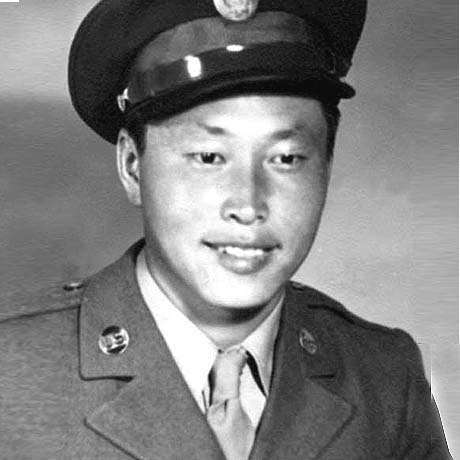
Private
George T. Sakato
1944: World War II
READ MOREGeorge T. Sakato
 1944: World War II
1944: World War II
Pvt. George T. Sakato served in Company E, 2nd Battalion, 44nd Regimental Combat Team. He was posthumously awarded the Distinguished Service Cross that was upgraded to the Medal of Honor for actions in the vicinity of Biffontaine, France, Oct. 29, 1944. Citation: Private George T. Sakato distinguished himself by extraordinary heroism in action on 29 October 1944, on hill 617 in the vicinity of Biffontaine, France. After his platoon had virtually destroyed two enemy defense lines, during which he personally killed five enemy soldiers and captured four, his unit was pinned down by heavy enemy fire. Disregarding the enemy fire, Private Sakato made a one-man rush that encouraged his platoon to charge and destroy the enemy strongpoint. While his platoon was reorganizing, he proved to be the inspiration of his squad in halting a counter-attack on the left flank during which his squad leader was killed. Taking charge of the squad, he continued his relentless tactics, using an enemy rifle and P-38 pistol to stop an organized enemy attack. During this entire action, he killed 12 and wounded two, personally captured four and assisted his platoon in taking 34 prisoners. By continuously ignoring enemy fire, and by his gallant courage and fighting spirit, he turned impending defeat into victory and helped his platoon complete its mission. Private Sakato's extraordinary heroism and devotion to duty are in keeping with the highest traditions of military service and reflect great credit on him, his unit, and the United States Army.
Related Articles
Congressional Medal of Honor Society.
Army.mil: 40 Bronze Stars awarded to Japanese-American vets
Army.mil: WWII Medal of Honor recipient 'shooting for 100'
Private George T. Sakato
1944: World War II
Pvt. George T. Sakato served in Company E, 2nd Battalion, 44nd Regimental Combat Team. He was posthumously awarded the Distinguished Service Cross that was upgraded to the Medal of Honor for actions in the vicinity of Biffontaine, France, Oct. 29, 1944. Citation: Private George T. Sakato distinguished himself by extraordinary heroism in action on 29 October 1944, on hill 617 in the vicinity of Biffontaine, France. After his platoon had virtually destroyed two enemy defense lines, during which he personally killed five enemy soldiers and captured four, his unit was pinned down by heavy enemy fire. Disregarding the enemy fire, Private Sakato made a one-man rush that encouraged his platoon to charge and destroy the enemy strongpoint. While his platoon was reorganizing, he proved to be the inspiration of his squad in halting a counter-attack on the left flank during which his squad leader was killed. Taking charge of the squad, he continued his relentless tactics, using an enemy rifle and P-38 pistol to stop an organized enemy attack. During this entire action, he killed 12 and wounded two, personally captured four and assisted his platoon in taking 34 prisoners. By continuously ignoring enemy fire, and by his gallant courage and fighting spirit, he turned impending defeat into victory and helped his platoon complete its mission. Private Sakato's extraordinary heroism and devotion to duty are in keeping with the highest traditions of military service and reflect great credit on him, his unit, and the United States Army.
Related Articles
Congressional Medal of Honor Society.
Army.mil: 40 Bronze Stars awarded to Japanese-American vets
Army.mil: WWII Medal of Honor recipient 'shooting for 100'
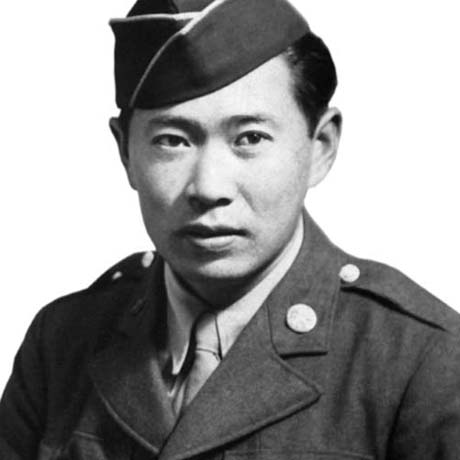
Technical Sergeant
Ted T. Tanouye
1944: World War II
READ MORETed T. Tanouye
 1944: World War II
1944: World War II
Tech. Sgt. Ted T. Tanouye served in the 44nd Regimental Combat Team. He was posthumously awarded the Distinguished Service Cross that was upgraded to the Medal of Honor for actions near Molino A Ventoabbto, Italy, July 7, 1944.Citation: Technical Sergeant Ted T. Tanouye distinguished himself by extraordinary heroism in action on 7 July 1944, near Molino A Ventoabbto, Italy. Technical Sergeant Tanouye led his platoon in an attack to capture the crest of a strategically important hill that afforded little cover. Observing an enemy machine gun crew placing its gun in position to his left front, Technical Sergeant Tanouye crept forward a few yards and opened fire on the position, killing or wounding three and causing two others to disperse. Immediately, an enemy machine pistol opened fire on him. He returned the fire and killed or wounded three more enemy soldiers. While advancing forward, Technical Sergeant Tanouye was subjected to grenade bursts, which severely wounded his left arm. Sighting an enemy-held trench, he raked the position with fire from his submachine gun and wounded several of the enemy. Running out of ammunition, he crawled 20 yards to obtain several clips from a comrade on his left flank. Next, sighting an enemy machine pistol that had pinned down his men, Technical Sergeant Tanouye crawled forward a few yards and threw a hand grenade into the position, silencing the pistol. He then located another enemy machine gun firing down the slope of the hill, opened fire on it, and silenced that position. Drawing fire from a machine pistol nest located above him, he opened fire on it and wounded three of its occupants. Finally taking his objective, Technical Sergeant Tanouye organized a defensive position on the reverse slope of the hill before accepting first aid treatment and evacuation. Technical Sergeant Tanouye's extraordinary heroism and devotion to duty are in keeping with the highest traditions of military service and reflect great credit on him, his unit, and the United States Army.
Related Articles
Congressional Medal of Honor Society
Technical Sergeant Ted T. Tanouye
1944: World War II
Tech. Sgt. Ted T. Tanouye served in the 44nd Regimental Combat Team. He was posthumously awarded the Distinguished Service Cross that was upgraded to the Medal of Honor for actions near Molino A Ventoabbto, Italy, July 7, 1944.Citation: Technical Sergeant Ted T. Tanouye distinguished himself by extraordinary heroism in action on 7 July 1944, near Molino A Ventoabbto, Italy. Technical Sergeant Tanouye led his platoon in an attack to capture the crest of a strategically important hill that afforded little cover. Observing an enemy machine gun crew placing its gun in position to his left front, Technical Sergeant Tanouye crept forward a few yards and opened fire on the position, killing or wounding three and causing two others to disperse. Immediately, an enemy machine pistol opened fire on him. He returned the fire and killed or wounded three more enemy soldiers. While advancing forward, Technical Sergeant Tanouye was subjected to grenade bursts, which severely wounded his left arm. Sighting an enemy-held trench, he raked the position with fire from his submachine gun and wounded several of the enemy. Running out of ammunition, he crawled 20 yards to obtain several clips from a comrade on his left flank. Next, sighting an enemy machine pistol that had pinned down his men, Technical Sergeant Tanouye crawled forward a few yards and threw a hand grenade into the position, silencing the pistol. He then located another enemy machine gun firing down the slope of the hill, opened fire on it, and silenced that position. Drawing fire from a machine pistol nest located above him, he opened fire on it and wounded three of its occupants. Finally taking his objective, Technical Sergeant Tanouye organized a defensive position on the reverse slope of the hill before accepting first aid treatment and evacuation. Technical Sergeant Tanouye's extraordinary heroism and devotion to duty are in keeping with the highest traditions of military service and reflect great credit on him, his unit, and the United States Army.
Related Articles
Congressional Medal of Honor Society
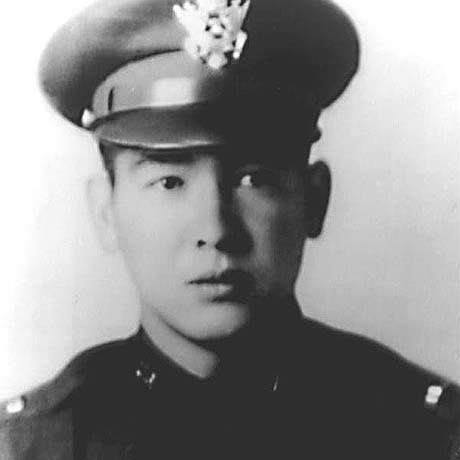
Captain
Francis B. Wai
1944: World War II
READ MOREFrancis B. Wai
 1944: World War II
1944: World War II
Capt. Francis B. Wai served in the 34th Infantry Regiment. He was posthumously awarded the Distinguished Service Cross that was upgraded to the Medal of Honor for actions in Leyte, Philippine Islands, Oct. 20, 1944. Citation: Captain Francis B. Wai distinguished himself by extraordinary heroism in action, on 20 October 1944, in Leyte, Philippine Islands. Captain Wai landed at Red Beach, Leyte, in the face of accurate, concentrated enemy fire from gun positions advantageously located in a palm grove bounded by submerged rice paddies. Finding the first four waves of American soldiers leaderless, disorganized, and pinned down on the open beach, he immediately assumed command. Issuing clear and concise orders, and disregarding heavy enemy machine gun and rifle fire, he began to move inland through the rice paddies without cover. The men, inspired by his cool demeanor and heroic example, rose from their positions and followed him. During the advance, Captain Wai repeatedly determined the locations of enemy strong points by deliberately exposing himself to draw their fire. In leading an assault upon the last remaining Japanese pillbox in the area, he was killed by its occupants. Captain Wai's courageous, aggressive leadership inspired the men, even after his death, to advance and destroy the enemy. His intrepid and determined efforts were largely responsible for the rapidity with which the initial beachhead was secured. Captain Wai's extraordinary heroism and devotion to duty are in keeping with the highest traditions of military service and reflect great credit on him, his unit, and the United States Army.
Related Articles
Congressional Medal of Honor Society
Captain Francis B. Wai
1944: World War II
Capt. Francis B. Wai served in the 34th Infantry Regiment. He was posthumously awarded the Distinguished Service Cross that was upgraded to the Medal of Honor for actions in Leyte, Philippine Islands, Oct. 20, 1944. Citation: Captain Francis B. Wai distinguished himself by extraordinary heroism in action, on 20 October 1944, in Leyte, Philippine Islands. Captain Wai landed at Red Beach, Leyte, in the face of accurate, concentrated enemy fire from gun positions advantageously located in a palm grove bounded by submerged rice paddies. Finding the first four waves of American soldiers leaderless, disorganized, and pinned down on the open beach, he immediately assumed command. Issuing clear and concise orders, and disregarding heavy enemy machine gun and rifle fire, he began to move inland through the rice paddies without cover. The men, inspired by his cool demeanor and heroic example, rose from their positions and followed him. During the advance, Captain Wai repeatedly determined the locations of enemy strong points by deliberately exposing himself to draw their fire. In leading an assault upon the last remaining Japanese pillbox in the area, he was killed by its occupants. Captain Wai's courageous, aggressive leadership inspired the men, even after his death, to advance and destroy the enemy. His intrepid and determined efforts were largely responsible for the rapidity with which the initial beachhead was secured. Captain Wai's extraordinary heroism and devotion to duty are in keeping with the highest traditions of military service and reflect great credit on him, his unit, and the United States Army.
Related Articles
Congressional Medal of Honor Society
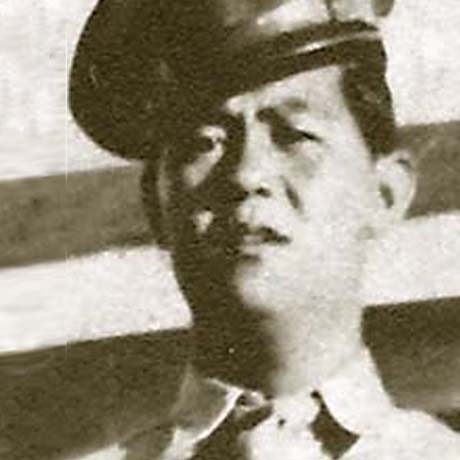
Lieutenant General
Mikio "Kio" Hasemoto
1943: World War II
READ MOREMikio "Kio" Hasemoto
 1943: World War II
1943: World War II
Pvt. Mikio Hasemoto, a Medal of Honor recipient, served in Company B, 100th Infantry Battalion (Seperate). He was posthumously awarded the Distinguished Service Cross that was upgraded to the Medal of Honor for his actions in the vicinity of Cerasuolo, Italy, Nov. 29, 1943. Citation: Private Mikio Hasemoto distinguished himself by extraordinary heroism in action on 29 November 1943, in the vicinity of Cerasuolo, Italy. A force of approximately 40 enemy soldiers, armed with machine guns, machine pistols, rifles, and grenades, attacked the left flank of his platoon. Two enemy soldiers with machine guns advanced forward, firing their weapons. Private Hasemoto, an automatic rifleman, challenged these two machine gunners. After firing four magazines at the approaching enemy, his weapon was shot and damaged. Unhesitatingly, he ran 10 yards to the rear, secured another automatic rifle and continued to fire until his weapon jammed. At this point, Private Hasemoto and his squad leader had killed approximately 20 enemy soldiers. Again, Private Hasemoto ran through a barrage of enemy machine gun fire to pick up an M-1 rifle. Continuing their fire, Private Hasemoto and his squad leader killed 10 more enemy soldiers. With only three enemy soldiers left, he and his squad leader charged courageously forward, killing one, wounding one, and capturing another. The following day, Private Hasemoto continued to repel enemy attacks until he was killed by enemy fire. Private Hasemoto's extraordinary heroism and devotion to duty are in keeping with the highest traditions of military service and reflect great credit on him, his unit, and the United States Army.
Related Articles
Congressional Medal of Honor Society
Lieutenant General Mikio "Kio" Hasemoto
1943: World War II
Pvt. Mikio Hasemoto, a Medal of Honor recipient, served in Company B, 100th Infantry Battalion (Seperate). He was posthumously awarded the Distinguished Service Cross that was upgraded to the Medal of Honor for his actions in the vicinity of Cerasuolo, Italy, Nov. 29, 1943. Citation: Private Mikio Hasemoto distinguished himself by extraordinary heroism in action on 29 November 1943, in the vicinity of Cerasuolo, Italy. A force of approximately 40 enemy soldiers, armed with machine guns, machine pistols, rifles, and grenades, attacked the left flank of his platoon. Two enemy soldiers with machine guns advanced forward, firing their weapons. Private Hasemoto, an automatic rifleman, challenged these two machine gunners. After firing four magazines at the approaching enemy, his weapon was shot and damaged. Unhesitatingly, he ran 10 yards to the rear, secured another automatic rifle and continued to fire until his weapon jammed. At this point, Private Hasemoto and his squad leader had killed approximately 20 enemy soldiers. Again, Private Hasemoto ran through a barrage of enemy machine gun fire to pick up an M-1 rifle. Continuing their fire, Private Hasemoto and his squad leader killed 10 more enemy soldiers. With only three enemy soldiers left, he and his squad leader charged courageously forward, killing one, wounding one, and capturing another. The following day, Private Hasemoto continued to repel enemy attacks until he was killed by enemy fire. Private Hasemoto's extraordinary heroism and devotion to duty are in keeping with the highest traditions of military service and reflect great credit on him, his unit, and the United States Army.
Related Articles
Congressional Medal of Honor Society
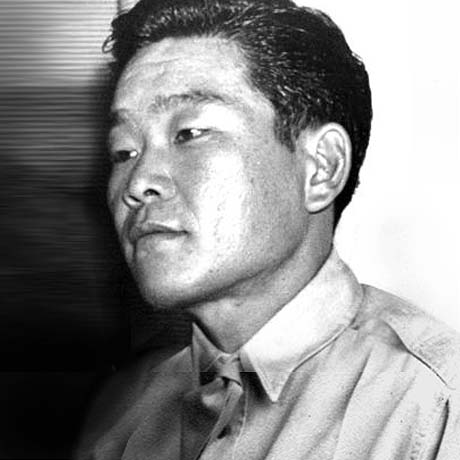
Private
Shizuya Hayashi
1943: World War II
READ MOREShizuya Hayashi
 1943: World War II
1943: World War II
Pvt. Shizuya Hayashi served in the 100th Infantry Battalion. He was posthumously awarded the Distinguished Service Cross that was upgraded to the Medal of Honor for his actions near Cerasuolo, Italy, Nov. 29, 1943. Citation: Private Shizuya Hayashi distinguished himself by extraordinary heroism in action on 29 November 1943, near Cerasuolo, Italy. During a flank assault on high ground held by the enemy, Private Hayashi rose alone in the face of grenade, rifle, and machine gun fire. Firing his automatic rifle from the hip, he charged and overtook an enemy machine gun position, killing seven men in the nest and two more as they fled. After his platoon advanced 200 yards from this point, an enemy antiaircraft gun opened fire on the men. Private Hayashi returned fire at the hostile position, killing nine of the enemy, taking four prisoners, and forcing the remainder of the force to withdraw from the hill. Private Hayashi's extraordinary heroism and devotion to duty are in keeping with the highest traditions of military service and reflect great credit on him, his unit, and the United States Army.
Related Articles
Congressional Medal of Honor Society
Private Shizuya Hayashi
1943: World War II
Pvt. Shizuya Hayashi served in the 100th Infantry Battalion. He was posthumously awarded the Distinguished Service Cross that was upgraded to the Medal of Honor for his actions near Cerasuolo, Italy, Nov. 29, 1943. Citation: Private Shizuya Hayashi distinguished himself by extraordinary heroism in action on 29 November 1943, near Cerasuolo, Italy. During a flank assault on high ground held by the enemy, Private Hayashi rose alone in the face of grenade, rifle, and machine gun fire. Firing his automatic rifle from the hip, he charged and overtook an enemy machine gun position, killing seven men in the nest and two more as they fled. After his platoon advanced 200 yards from this point, an enemy antiaircraft gun opened fire on the men. Private Hayashi returned fire at the hostile position, killing nine of the enemy, taking four prisoners, and forcing the remainder of the force to withdraw from the hill. Private Hayashi's extraordinary heroism and devotion to duty are in keeping with the highest traditions of military service and reflect great credit on him, his unit, and the United States Army.
Related Articles
Congressional Medal of Honor Society
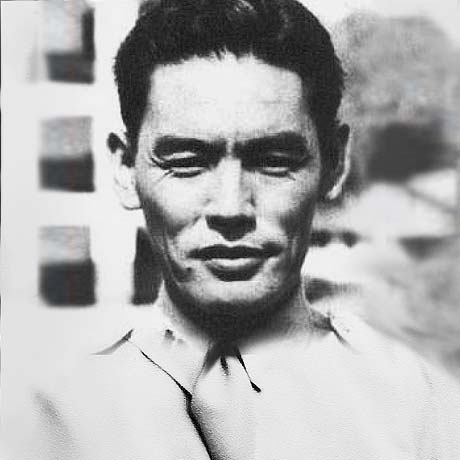
Sergeant
Allan M. Ohata
1943: World War II
READ MOREAllan M. Ohata
 1943: World War II
1943: World War II
Sgt. Allan M. Ohata served in the 100th Infantry Battalion. He was posthumously awarded the Distinguished Service Cross that was upgraded to the Medal of Honor for his actions near Cerasuolo, Italy, Nov. 29 and 30, 1943. Citation: Sergeant Allan M. Ohata distinguished himself by extraordinary heroism in action on 29 and 30 November 1943, near Cerasuolo, Italy. Sergeant Ohata, his squad leader, and three men were ordered to protect his platoon's left flank against an attacking enemy force of 40 men, armed with machine guns, machine pistols, and rifles. He posted one of his men, an automatic rifleman, on the extreme left, 15 yards from his own position. Taking his position, Sergeant Ohata delivered effective fire against the advancing enemy. The man to his left called for assistance when his automatic rifle was shot and damaged. With utter disregard for his personal safety, Sergeant Ohata left his position and advanced 15 yards through heavy machine gun fire. Reaching his comrade's position, he immediately fired upon the enemy, killing 10 enemy soldiers and successfully covering his comrade's withdrawal to replace his damaged weapon. Sergeant Ohata and the automatic rifleman held their position and killed 37 enemy soldiers. Both men then charged the three remaining soldiers and captured them. Later, Sergeant Ohata and the automatic rifleman stopped another attacking force of 14, killing four and wounding three while the others fled. The following day he and the automatic rifleman held their flank with grim determination and staved off all attacks. Staff Sergeant Ohata's extraordinary heroism and devotion to duty are in keeping with the highest traditions of military service and reflect great credit on him, his unit, and the United States Army.
Related Articles
Congressional Medal of Honor Society
Sergeant Allan M. Ohata
1943: World War II
Sgt. Allan M. Ohata served in the 100th Infantry Battalion. He was posthumously awarded the Distinguished Service Cross that was upgraded to the Medal of Honor for his actions near Cerasuolo, Italy, Nov. 29 and 30, 1943. Citation: Sergeant Allan M. Ohata distinguished himself by extraordinary heroism in action on 29 and 30 November 1943, near Cerasuolo, Italy. Sergeant Ohata, his squad leader, and three men were ordered to protect his platoon's left flank against an attacking enemy force of 40 men, armed with machine guns, machine pistols, and rifles. He posted one of his men, an automatic rifleman, on the extreme left, 15 yards from his own position. Taking his position, Sergeant Ohata delivered effective fire against the advancing enemy. The man to his left called for assistance when his automatic rifle was shot and damaged. With utter disregard for his personal safety, Sergeant Ohata left his position and advanced 15 yards through heavy machine gun fire. Reaching his comrade's position, he immediately fired upon the enemy, killing 10 enemy soldiers and successfully covering his comrade's withdrawal to replace his damaged weapon. Sergeant Ohata and the automatic rifleman held their position and killed 37 enemy soldiers. Both men then charged the three remaining soldiers and captured them. Later, Sergeant Ohata and the automatic rifleman stopped another attacking force of 14, killing four and wounding three while the others fled. The following day he and the automatic rifleman held their flank with grim determination and staved off all attacks. Staff Sergeant Ohata's extraordinary heroism and devotion to duty are in keeping with the highest traditions of military service and reflect great credit on him, his unit, and the United States Army.
Related Articles
Congressional Medal of Honor Society
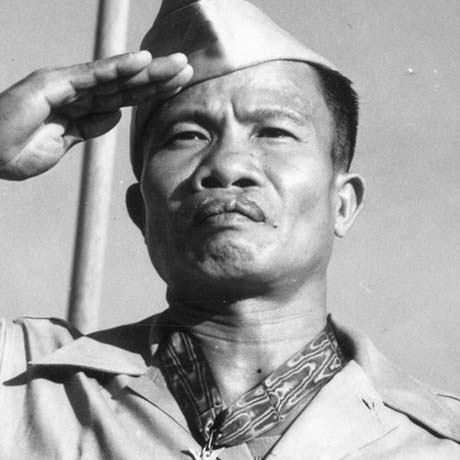
Sergeant
Jose Calugas
1942: World War II
READ MOREJose Calugas
 1942: World War II
1942: World War II
Sgt. Jose Calugas served in Battery B, 88th Field Artillery, Philippine Scouts, Jan. 16, 1942. Citation: The action for which the award was made took place near Culis, Bataan Province, Philippine Islands, on 16 January 1942. A battery gun position was bombed and shelled by the enemy until 1 gun was put out of commission and all the cannoneers were killed or wounded. Sgt. Calugas, a mess sergeant of another battery, voluntarily and without orders ran 1,000 yards across the shell-swept area to the gun position. There he organized a volunteer squad which placed the gun back in commission and fired effectively against the enemy, although the position remained under constant and heavy Japanese artillery fire.
Related Articles
Congressional Medal of Honor Society
Sergeant Jose Calugas
1942: World War II
Sgt. Jose Calugas served in Battery B, 88th Field Artillery, Philippine Scouts, Jan. 16, 1942. Citation: The action for which the award was made took place near Culis, Bataan Province, Philippine Islands, on 16 January 1942. A battery gun position was bombed and shelled by the enemy until 1 gun was put out of commission and all the cannoneers were killed or wounded. Sgt. Calugas, a mess sergeant of another battery, voluntarily and without orders ran 1,000 yards across the shell-swept area to the gun position. There he organized a volunteer squad which placed the gun back in commission and fired effectively against the enemy, although the position remained under constant and heavy Japanese artillery fire.
Related Articles
Congressional Medal of Honor Society
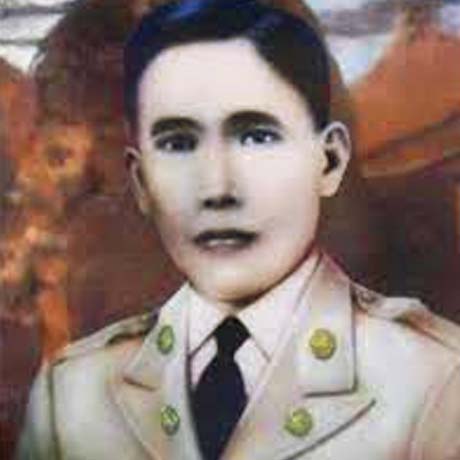
Private
Jose B. Nisperos
1912: First Medal of Honor Recipient of Asian Descent
READ MOREJose B. Nisperos
 1912: First Medal of Honor Recipient of Asian Descent
1912: First Medal of Honor Recipient of Asian Descent
Pvt. Jose B. Nisperos became the first person of Asian descent to be awarded the Medal of Honor for his actions on Sept. 24, 1911, while engaged in combat at Lapurap, Basilan, Philippine Islands. He served in the 34th Company, Philippine Scouts. In 1913, having been badly wounded — his left arm was broken and lacerated and with several spear wounds in the body so that he could not stand — Nisperos continued to fire his rifle with one hand until the enemy was repulsed, thereby aiding materially in preventing the annihilation of his party.
Related Articles
Congressional Medal of Honor Society .
Private Jose B. Nisperos
1912: First Medal of Honor Recipient of Asian Descent
Pvt. Jose B. Nisperos became the first person of Asian descent to be awarded the Medal of Honor for his actions on Sept. 24, 1911, while engaged in combat at Lapurap, Basilan, Philippine Islands. He served in the 34th Company, Philippine Scouts. In 1913, having been badly wounded — his left arm was broken and lacerated and with several spear wounds in the body so that he could not stand — Nisperos continued to fire his rifle with one hand until the enemy was repulsed, thereby aiding materially in preventing the annihilation of his party.
Related Articles
Congressional Medal of Honor Society .